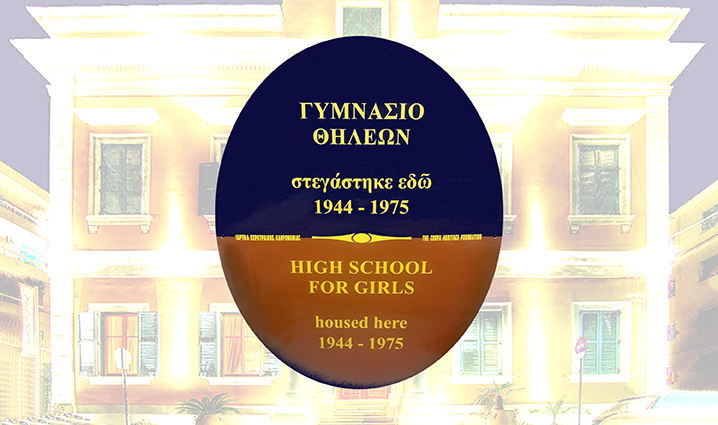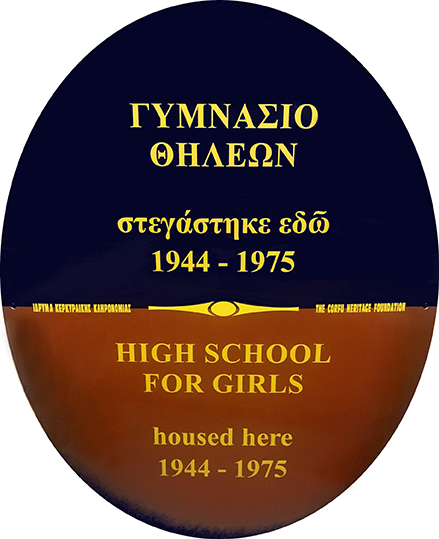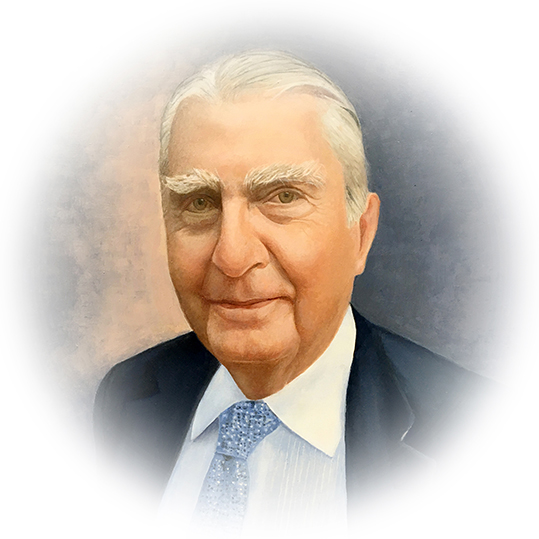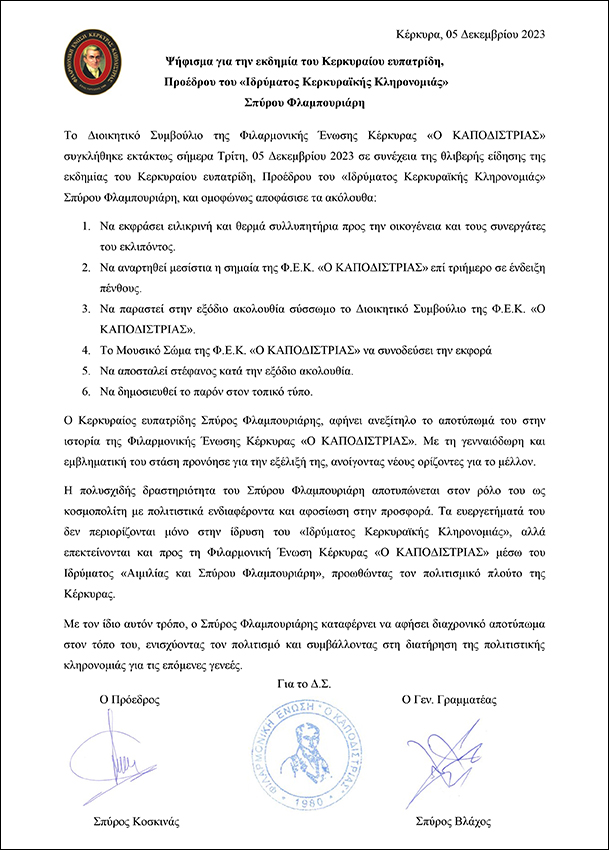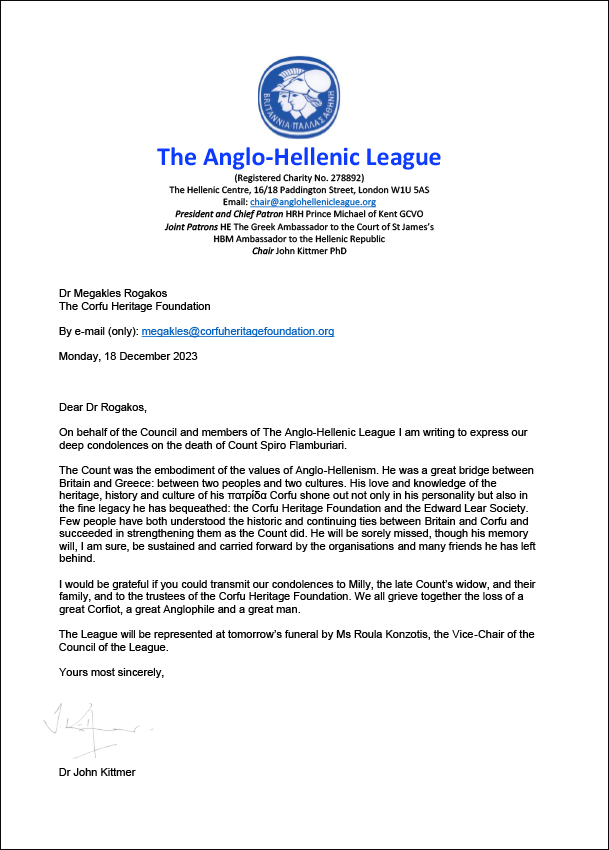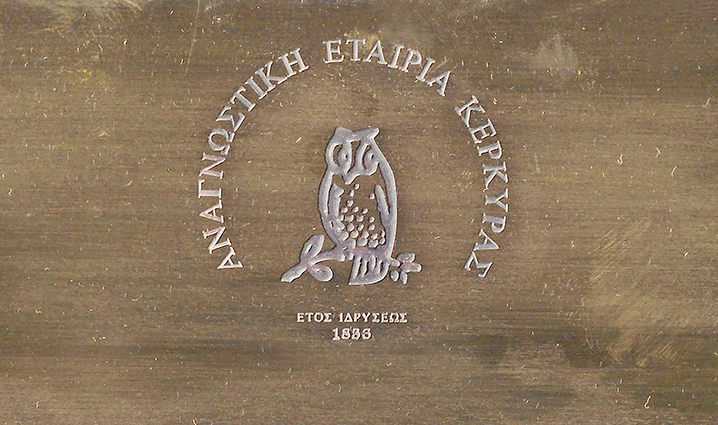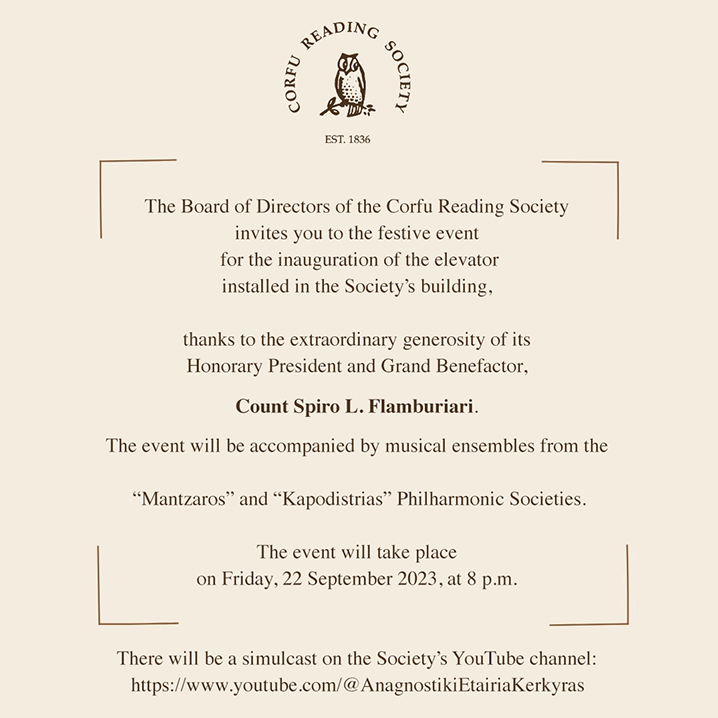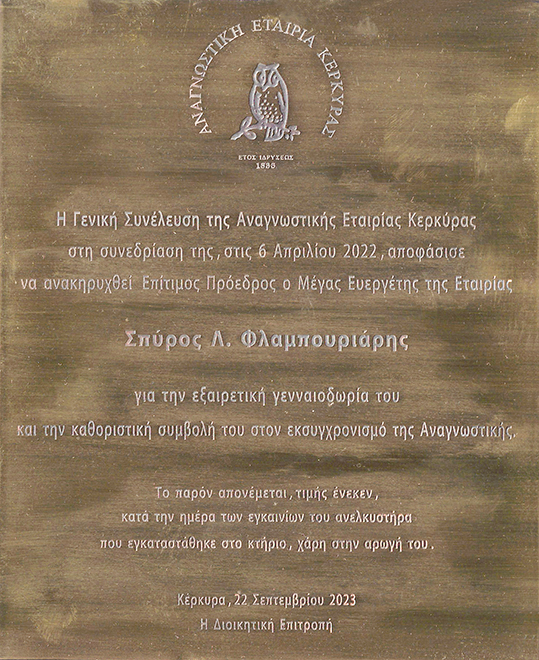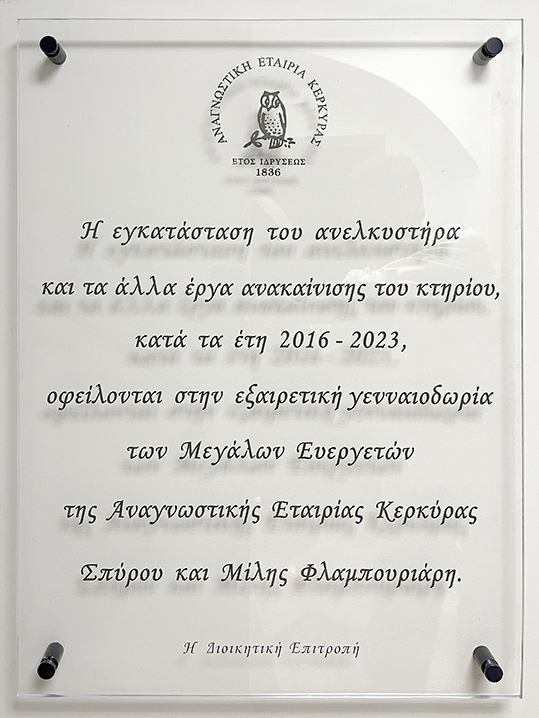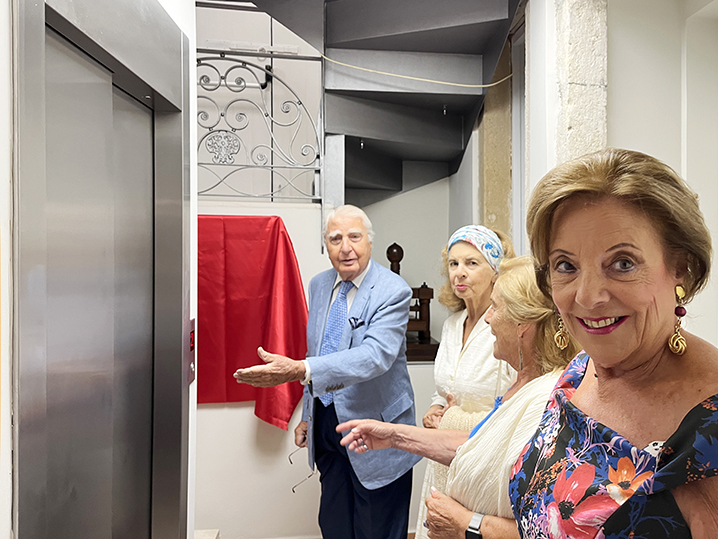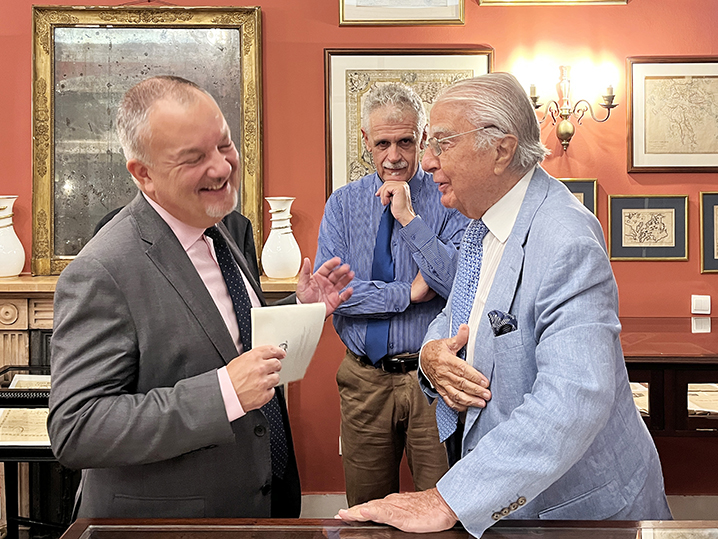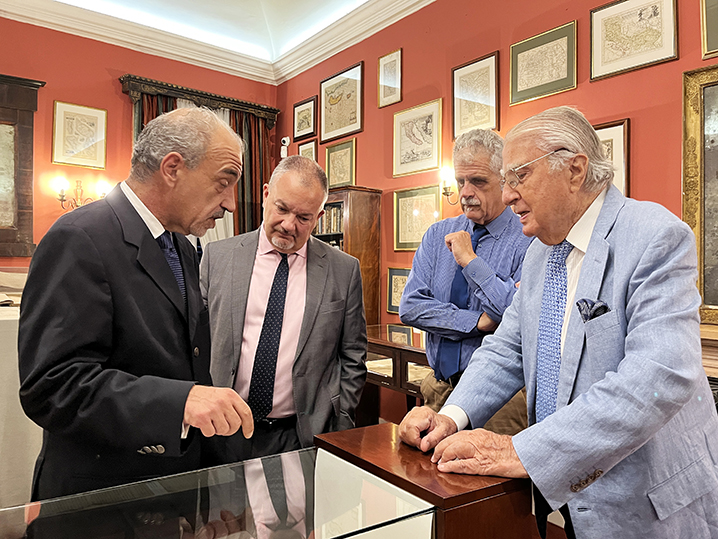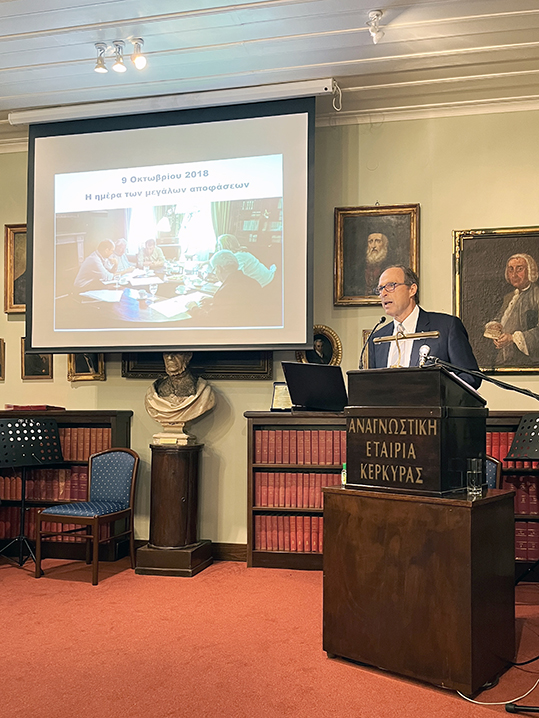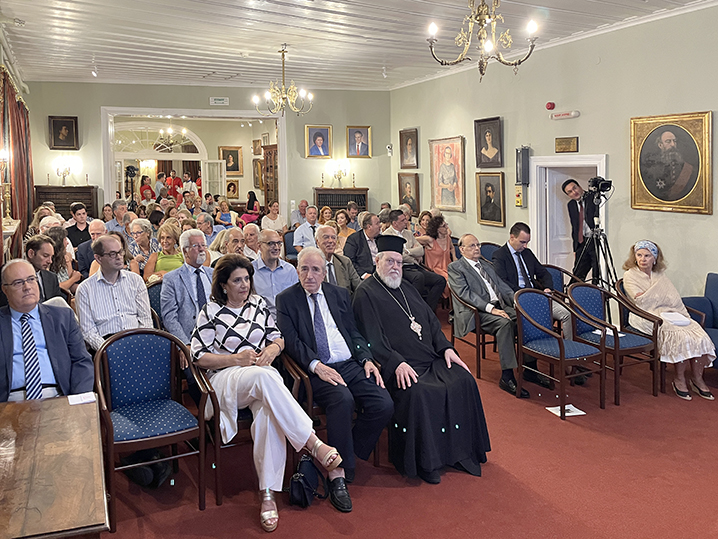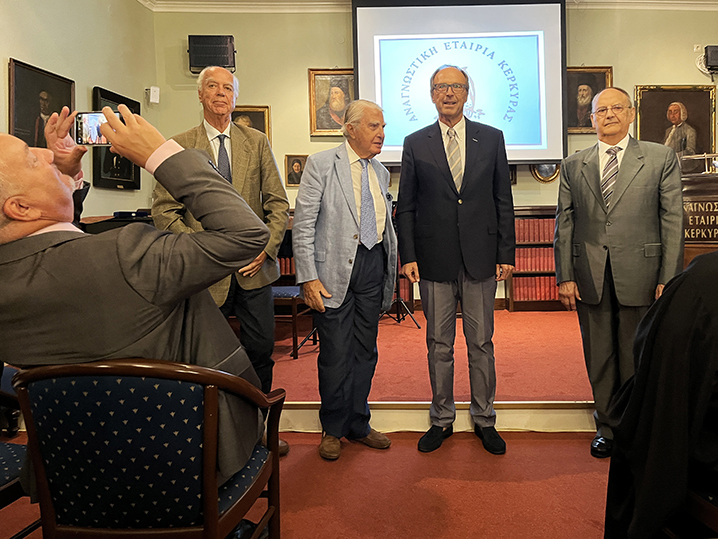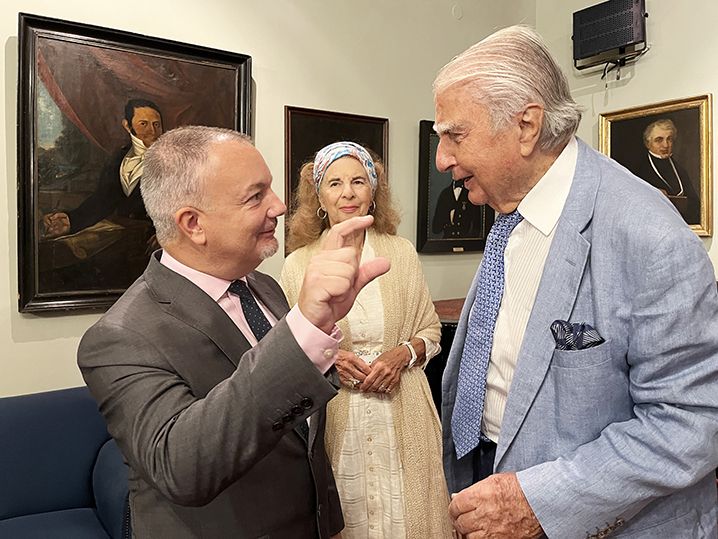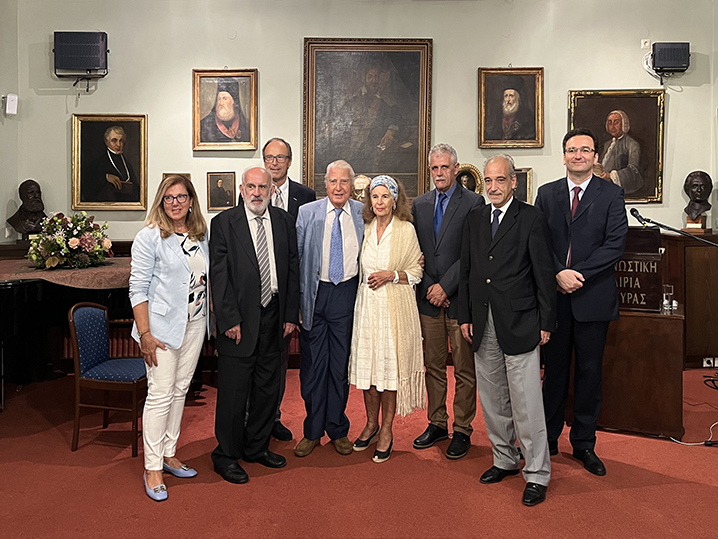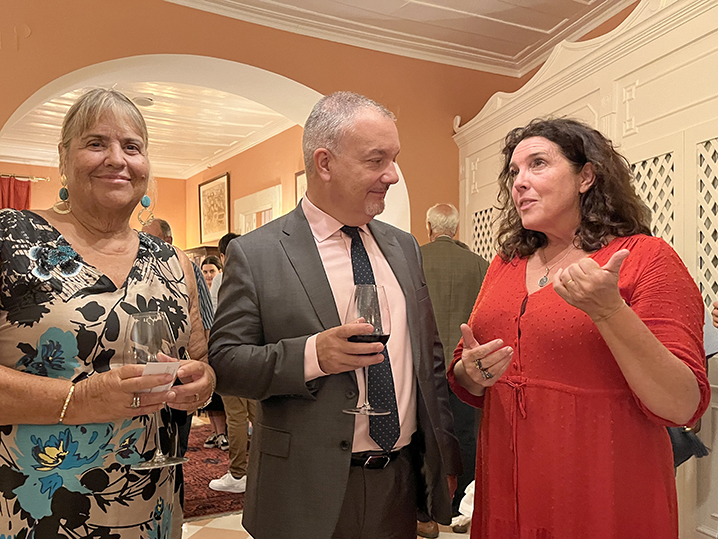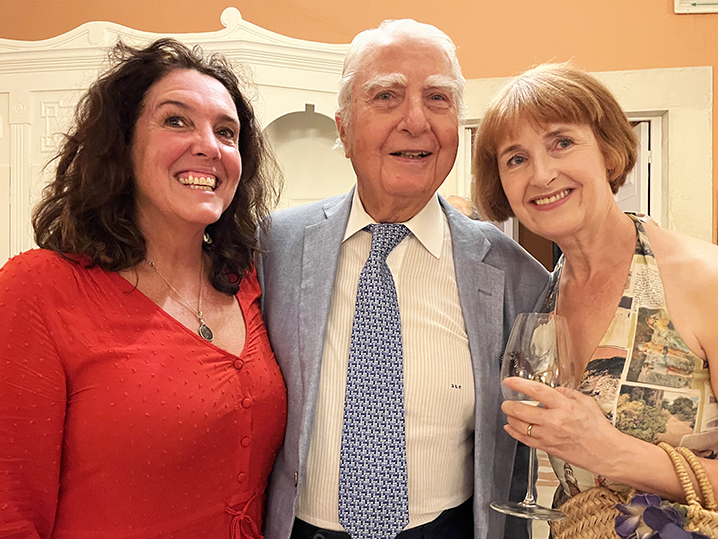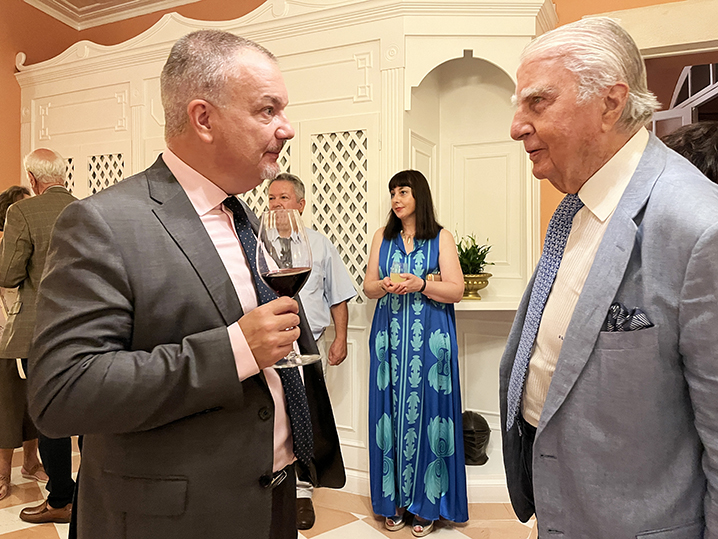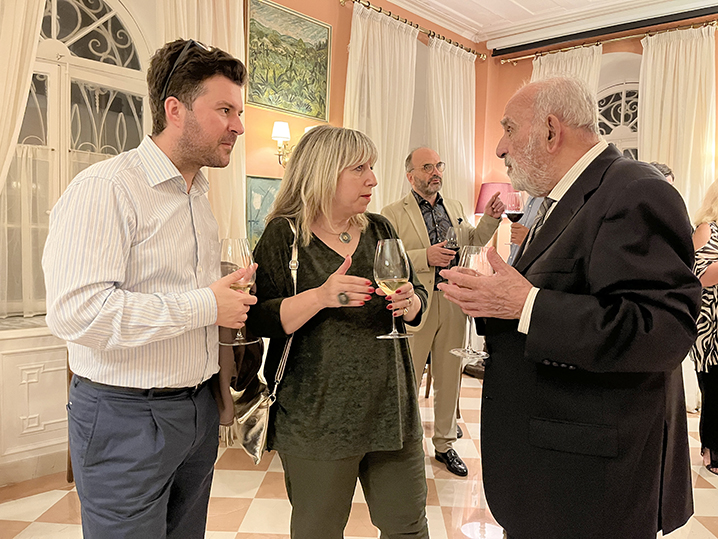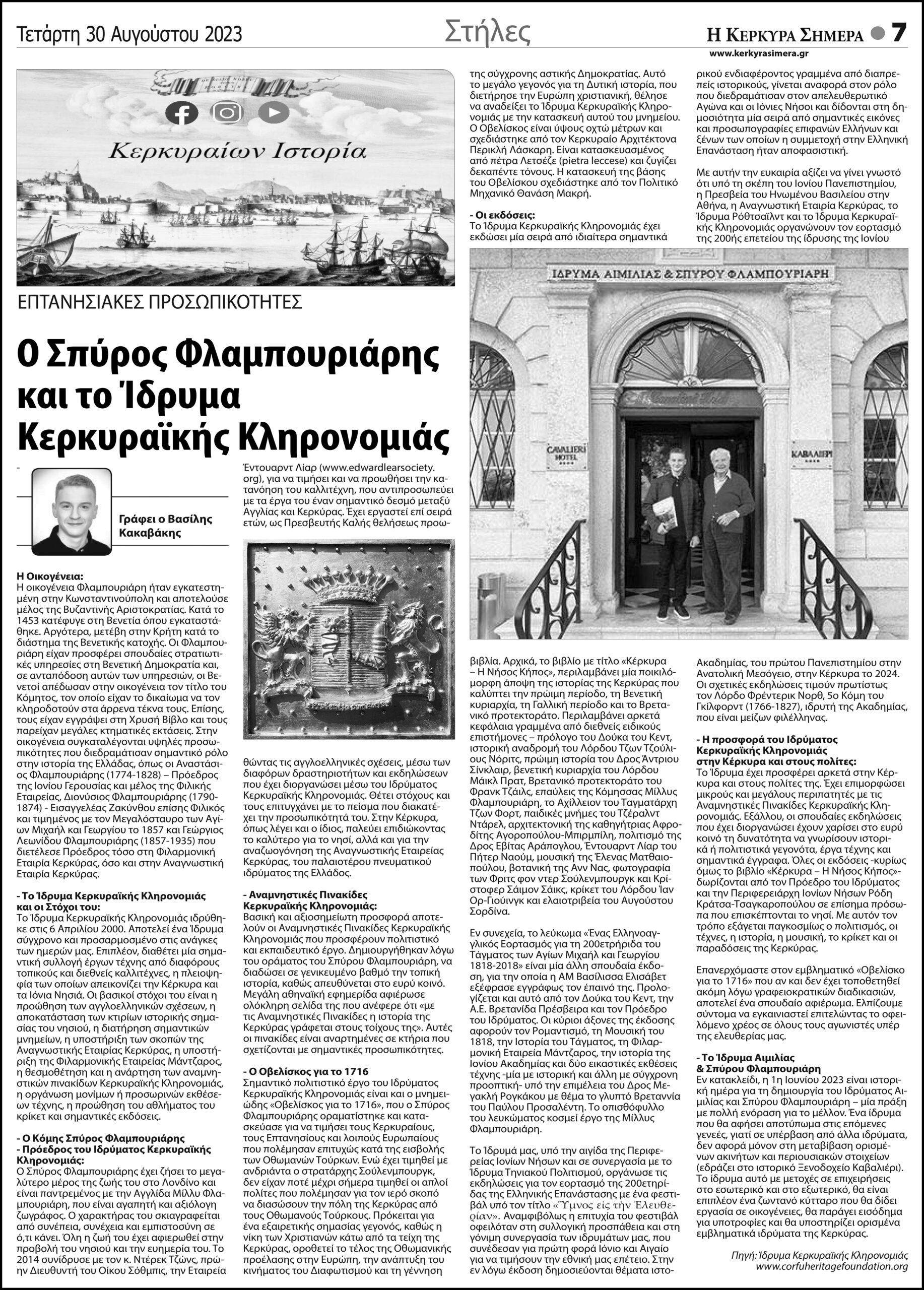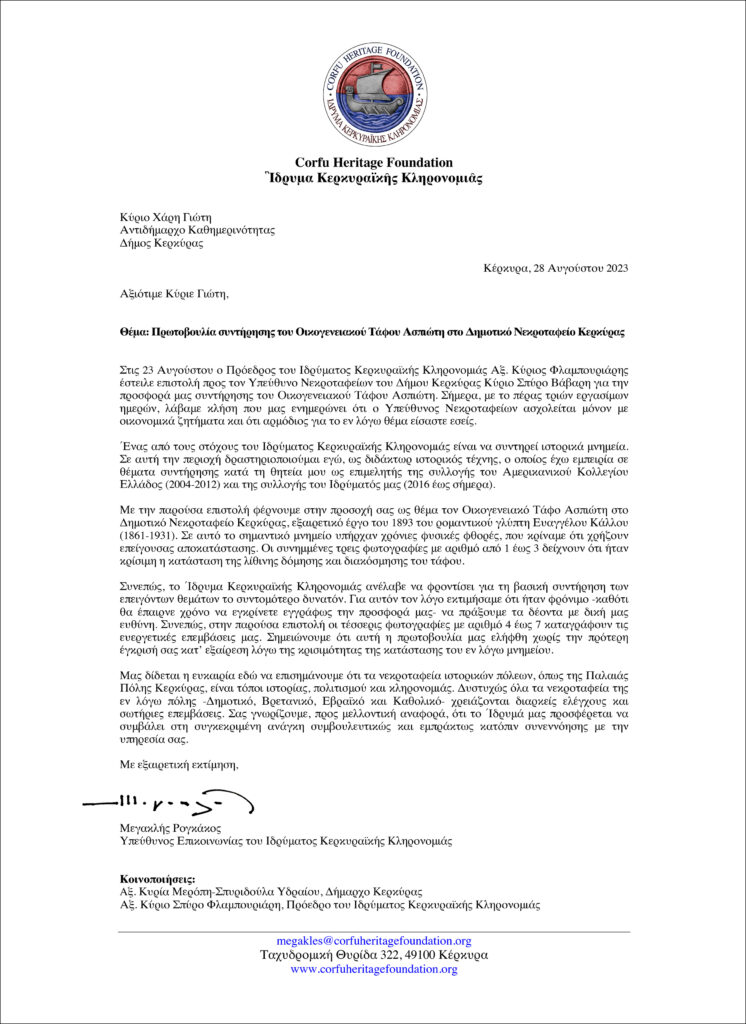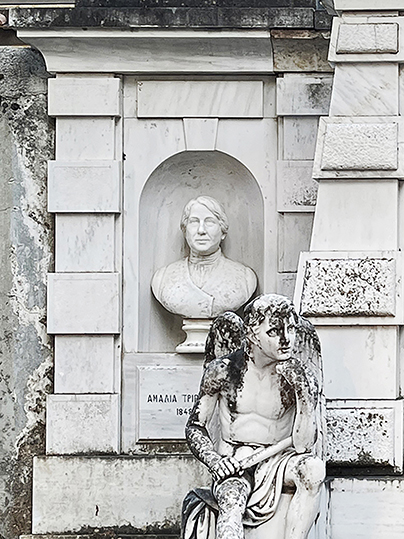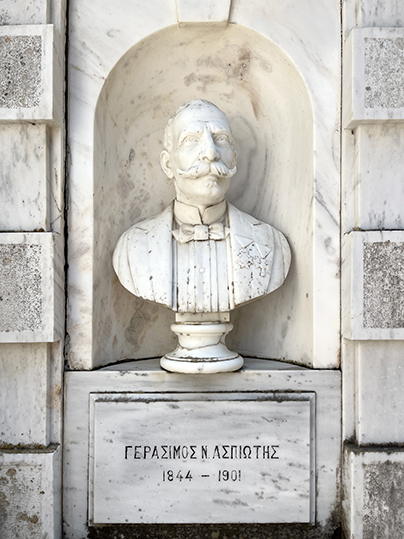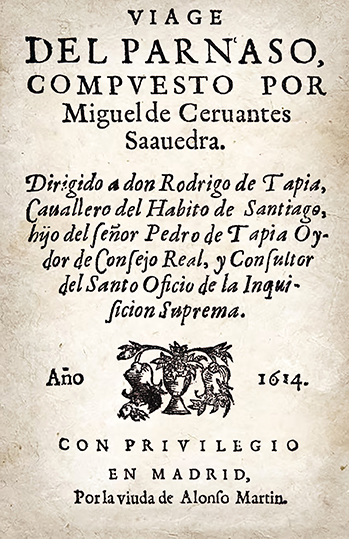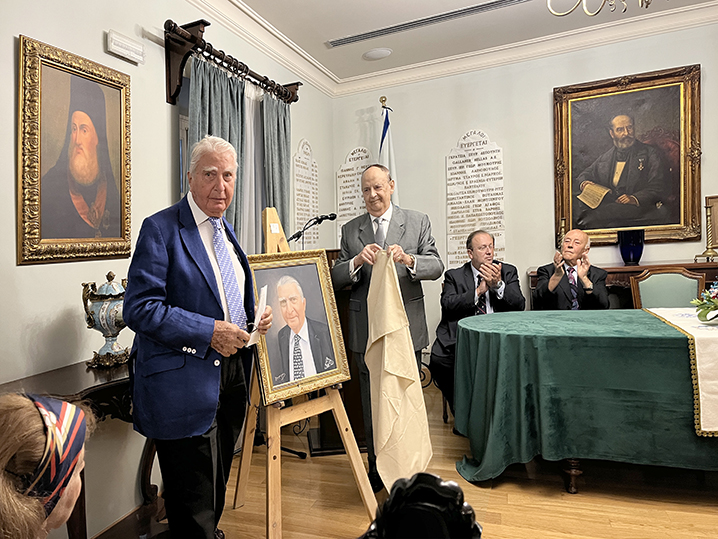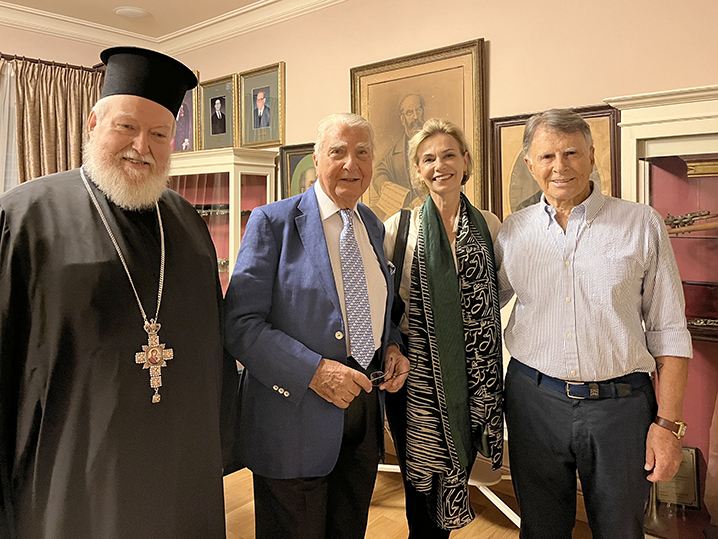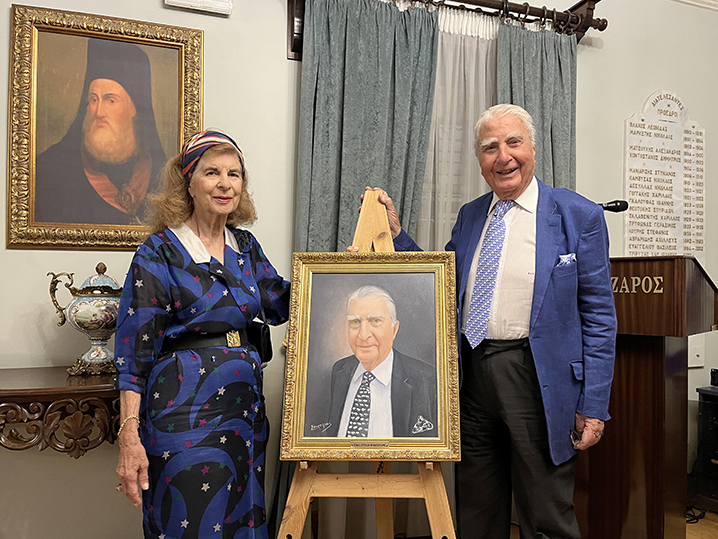[FOR GREEK TEXT SEE BELOW]
§
IMPORTANT PRE-NOTE
In the interests of natural justice, the substance of this presentation has been laid before Mr Thanasis Makris, Chair of the Corfu Reading Society, to give him a full opportunity to respond to it or object to it before its now publication and general circulation.
Mr Makris has failed to make any response or objection to it.
In light of this failure to respond or object, it must be said that any straightforward person – when faced with the statements and documentation contained in this presentation – would be keen to justify his actions and put the record straight.
In this particular context it must be said:-
- bearing in mind the long period of time Mr Makris and Dr Rogakos have been mutually concerned in this matter and
- Mr Makris’ usual keenness to use immediate and forthright emails as a course of conduct in the context of this matter and
- his now silence and failure to respond to the invitation to comment on this presentation
indicates, at least prima facie, acknowledgment that the terms of this presentation are correct
- and that
his now silence does not impediment any reasonable person taking the view that this presentation is correct in respect of the wronging of Dr Rogakos by Mr Makris and the damage done to Dr Rogakos both reputationally and financially
- and that
Having caused irreparable damage, economic and reputational, Mr Makris does not seem concerned in any way to answer for it or justify it, having been given an opportunity to do so –
- It is in this latter context that this presentation report is published.
PRESENTATION
It is with great regret that today we announce the malicious disruption of the anniversary Album “Guilford 1824 – 200th anniversary of the Ionian Academy” and the related exhibition “Your most obedient servant and friend Earl of Guilford” that was scheduled to run at the building of the former Ionian Parliament, Corfu, in the period 1st – 30th August 2024.
This significant and historic event was first proposed by a letter of Dr Megakles Rogakos, Curator of the Corfu Heritage Foundation – (‘CHF’), to Mr Thanasis Makris, Chair of the Corfu Reading Society – (‘CRS’), on 18th August 2021. An exhibition was planned to be based on a selection of significant artefacts pertaining to the founding of the Ionian Academy, kept in the Corfu Guilford Archive, acquired, for the public good, by the CRS at an auction in London in 1981.
Dr Rogakos brought Pietro Mancion’s (1803-1888) portrait of Guilford and the University of Oxford’s degree awarded to him in 1819, to the attention of Lord Jacob Rothschild and Count Spiro Flamburiari, who, led by their love for Corfu and its heritage, donated these works to the Ionian University. They were placed in the reception hall of the Rectorate of the Ionian University and were unveiled at a special event there on 7th May 2022.
By a letter of 17th April 2023, Count Flamburiari informed Professor Andreas Floros, Chancellor of the Ionian University, that both H.M. Ambassador of the United Kingdom to Athens and Lord Jacob Rothschild, had agreed to participate, as co-ordinators, in a 2024 anniversary project of the founding of the Lord Guilford’s Ionian Academy which is the predecessor of the Ionian University. The CHF and the Rothschild Foundation would sponsor the event and had agreed to share any costs of it equally.
By a letter of 17th April 2023, Count Flamburiari informed Professor Floros and Mr Makris that the employment of Dr Rogakos – as representative and scientific associate to the project in the organisation of the events – as a precondition of Count Flamburiari’s involvement. He emphasised Dr Rogakos’ knowledge about Guilford and reminded them of his successful involvement and supervision of the 2021 national anniversary events.
In a letter of 6th July 2023, Dr Rogakos submitted to Professor Emerita Helen Angelomatis, Professor Ilias Yarenis and Professor Nikolaos Karapidakis, Editorial Board of the Ionian University, his scientifically drawn up proposal for their approval. This proposal was arranged in seven sections: 1) portraits of Guilford; 2) portraits of personalities in the circle of Guilford; 3) portraits of associates of the Ionian Academy; 4) archival material; 5) documentary evidence; 6) books; 7) contemporary art exhibition.
All these details were fully developed with images at the following hyperlink: www.corfuheritagefoundation.org/1824-2/.
Unfortunately, the two main supporters of the event died soon thereafter in a short period of time – Count Flamburiari died on 5th December 2023 and Lord Rothschild died on 26th February 2024. The ensuing power gap seemed to allow the opportunity to other, previously ‘super-numerical’, persons to behave erratically towards the CHF and this anniversarian project. Professor Floros ceased to respond to letters sent to him by Dr Rogakos and by Countess Milly Flamburiari, the successor Chair of the CHF.
On 26th February 2024, Dr Rogakos sent by letter to the Board of Directors of the Flamburiari Foundation, which includes Mr Makris, the quote for the cost of the anniversary Album. At their reluctance to respond, Dr Rogakos found that their excuses (later to be found to be fictional excuse) was “inability to contribute” owing to bureaucratic delays. The Rothschild Foundation stepped into this crisis by accepting to cover the full costs unilaterally.
This was a fictional excuse because later, Mr Makris, by an email to Dr Rogakos of 14th July 2024, demanded, that he immediately remove from the Album any reference to the CRS and its Chair. This demand was contrary to all previous arrangements and agreements in reliance upon which much time and expense had been expended, particularly by Count Flamburiari, Dr Rogakos and the Rothschild Foundation.
Mr Makris, wholly improperly and unlawfully, threatened that, in the event of Dr Rogakos’ failure to comply with his demand by 16th July 2024, would expose the issue by a public denial by him and the CRS.
Following on this wholly improper and unlawful threat, on 19th July 2024, he did, indeed, recklessly, unlawfully and with malicious intent, issue this threatened denial to many and various recipients, including diplomats, academicians, partners and others who had contributed to the Album.
Though representing the oldest cultural institution in Greece, founded in 1836, Mr Makris misrepresented the true position on two occasions.
First, by writing that the CHF had had no permission for this collaboration.
In fact, permission was given by Mr Makris’ letter to Count Flamburiari on 3rd January 2023 (the relevant letter is reproduced here). The letterhead, mentioning the CRS’s participation, then appeared as early as 8th July 2023 (the relevant letter is also reproduced here).
Second, Mr Makris misrepresented, again by writing, that Dr Rogakos did not respond to his request by the deadline he imposed.
Indeed, Dr Rogakos did respond by letter on 15th July 2024 (the relevant letter is reproduced here as well), which gave all parties a way out the extreme inconvenience that Mr Makris had intentionally caused.
As a result Mr Makris has recklessly, maliciously and with intent, caused Dr Rogakos grave professional disreputation, especially toward the Municipality of Corfu.
By a letter of 22nd July 2024, Dr Rogakos demanded that Mr Makris make apology and thereby to make amends to the offence in public at once, without any delay.
More importantly, Dr Rogakos reminded him that this imminent anniversary event was of national significance and that it would be best that they fulfilled the unison wish of the late Chairs, Count Flamburiari and Lord Rothschild, to honour Guilford in the best possible way.
At the same time that tribute should be paid to the memory of these two beloved late patrons of Corfu.
Sadly, Mr Makris did not do so – instead, he made matters even worse.
Exposing his intent all along since the death of Count Flamburiari, by a letter on the same day, 22nd July 2024, he repeated his unlawful demands even more stridently in no uncertain terms as follows :-
“1) We do not permit you and any third party to use our intellectual property rights over the CRS’s material.
2) We do not consent to the organisation of the exhibition in which material from our collections are to be exhibited without our approval.
3) We do not approve of the circulation in any form – digital, printed, etc. – of an exhibition catalogue depicting material from the CRS’s collections.
4) We disagree with all your actions, which portray us as collaborating with you.”
All the above was contrary to that which had been agreed during the months of preparation for the Album and event in question.
All that work and expense was expended in reliance on the good faith agreements reached and fully discussed with Mr Makris and the CRS.
All this work and expense, as well as reputational exposure, was summarily trashed, by Mr Makris as though all the good faith agreements and the work and expense expended in reliance on those good faith agreements accordingly, had been meaningless.
Mr Makris who could not have been unaware of the reputational and economic damage his deviation from all the plans and good faith agreements that had gone before would cause.
Unfortunately, by this prolonged and maliciously intended negative action Mr Makris tarnishes not only the honouring of Guilford, but also the memory of Count Flamburiari and Lord Rothschild.
Let us hope the members of the CRS may take heed of this important issue – to evolve from the past and properly to modernise its outlook and administration.
Based on the motto of the Most Distinguished Order of Saint Michael and Saint George, “Auspicium Melioris Aevi” (In Augury of a Better Age), we promise to all our good friends at the CHF and good members of the CRS:-
That this anniversary event, with the accompanying Album publication, will yet materialise with the help of other and superior powers who do not allow fear to kill dreams…
The homage to Lord Guilford and the honouring of Count Flamburiari and Lord Rothschild will yet be achieved … despite the malicious interventions by some personages in Corfu.
Spyros I. Nicolaou
Honorary Councillor of the State
Athens, 24th July 2024
§
[TRANSLATION OF LETTER FROM THE ORIGINAL GREEK TO ENGLISH]
Mr Thanasis Makris, Chair of the Corfu Reading Society
Corfu, 18 August 2021
Dear Mr Makris,
Subject: Exhibition on the 200th anniversary of the founding of the Ionian University for 2024
I hope you are well.
The Corfu Heritage Foundation, aiming to promote Anglo-Hellenic relations, in close collaboration with the Ionian University, will soon propose to the Municipal Gallery of Corfu to organise an important anniversary exhibition for Frederick North, Count of Guilfotd, founder of the Ionian Academy, and the 200 years since the foundation of the Ionian University during the summer months of 2024. Count Flamburiari (notified) wishes to bring the Corfu Heritage Foundation and the Corfu Reading Society under the umbrella of the Ionian University.
The Rector of the Ionian University, Professor Floros (also cc-ed), asked us to present him with a state of art works and evidence for the anniversary exhibition in question. For this reason and in order to prepare for our meeting with Professor Floros on 24 August, I would like to digitise the following 26 documents from the Corfu Guildford Archive.
Our rationale is to commission expert historians to undertake studies that comment on any of the evidence in question they choose. I am available immediately to oversee the digitisation. I think I will need to use the documentation tower for a day.
Please let me know your decision regarding our specific request as soon as possible.
Best wishes and kind regards,
Megakles Rogakos, MA MA Phd
Curator of the Corfu Heritage Foundation
Cc: Professor Andreas Floros, Rector of the Ionian University
Count Spiro Flamburiari, Chair of the Corfu Heritage Foundation
§
SELECTION OF 26 ARTEFACTS FROM THE CORFU GUILFORD ARCHIVE
Φ III 46.- 25.10.1819 | Printed announcement of the book offering from the University of Cambridge to the Ionian Academy, in English.
Φ IV 4.- 5.4.1820 | Printed presentation of the founding of the Ionian Academy in Ithaca, in Italian.
Φ IV 5.- 7.3.1820 | Letter from K. Logothetis to Guilford, in Greek, praising and thanking the English.
Φ IV 11.- 25.3.1820 | Document of the senate of the Ionian State, in Italian, which appoints Guilford lord of the university.
Φ IV 25.- 31.1.1820 | Printed notification in Latin of the book offering from the University of Cambridge to the Ionian Academy.
Φ V 5.- 17.5.1824 | Plan for the founding of the Ionian Academy, in English.
Φ V 14.- 11.11.1824 | Announcement of the Archon of the Academy, in Italian, announcing uniforms, appearance and conduct.
Φ V 17.- 27.12.1824 | Letter from Guilford to Dimitrios Schinas (Librarian 1819-1824), in Italian, containing the sender’s coat of arms.
Φ V 20.- 14.2.1825 | Letter from Guilford to Henry Bathurst, in English, referring to the operation of the Academy.
Φ V 28.- 22.4.1825 | Letter from Guilford to Henry Bathurst, in English, referring to the secularism of the Academy.
Φ VIII 46.- 30.11.1827 | Letter from Frederick Adam to anonymous, in English, mentioning Guilford’s death.
Φ VIII 47.- 24.12.1827 | Letter from Ioannis Chronis to anonymous, in Italian, mourning Guilford’s death.
Φ VIII 48.- 27.12.1827 | Letter from Guilford to Sheffield, in French, informing him of Guilford’s instructions for the operation of the library after his death.
Φ VIII 64.- 15.8.1829 | Report by A. Papadopoulos-Vretos, in Italian, on the library.
Φ VIII 66.- 10.1830 | Catalogue of books from the library, in Italian.
Φ IX 6.- after 1819 | Document with text praising Guilford, in Latin.
Φ IX 10.- about 1820 | Document with four verses by hieromonk Daniel Varizios praising Guilford, in Greek and calligraphic.
Φ IX 18.- about 1820 | Document with praise of the hieromonk Manuel Petalas Ioannis for the Kingdom of England, for Great Britain and Guilford, in Greek.
Φ IX 35.- circa 1820 | Hymn, with elements from classical literature, by an anonymous author for Guilford, in Greek.
Φ IX 36.- circa 1820 | A hymn, with 39 verses, for the Greek education of Guilford, by Bernardo Zamania, in Latin.
Δ 1.- 27.5.1814 | Diploma of the election of Guilford as President of the Board of Directors of the Philomuse Society, in Greek.
Δ 2.- 4.3.1817 | Guilford’s certificate from the Italian Academy, in Italian.
Δ 3.- 10.4.1820 | Guilford’s certificate from the Etruscan Academy, in Italian.
Δ 4.- 8.8.1820 | Letter from the University of Cambridge to Guilford, as Chancellor of the Academy, in Latin.
Δ 5.- 19.4.1822 | Guilford’s certificate from the Royal Academy of Lucca, in Italian.
Τ 1.- 13.10.1827 | Guilford’s will, which among other things defines his donations to the Ionian Academy, in English.
• Daphne I. D. Kyriaki. Corfu Guilford Archive. Corfu, GR: Corfu Reading Society, 1984.
§

§
[TRANSLATION OF LETTER ABOVE FROM THE ORIGINAL GREEK TO ENGLISH]
Corfu, 3 January 2023
Protocol number Gr.002/2023
To: Professor Ilias Yarenis, Vice Chancellor of the Ionian University
Cc: Professor Andreas Floros, Rector of Ionian University,
Spiro Flamburiari, Chair of the Corfu Heritage Foundation
Dear Professor Yarenis,
Thank you very much for your kind letter of 7 December and for your honourable proposal to collaborate on the exhibition for the Founder of the Ionian Academy, Lord Guilford, on the occasion of the 200th anniversary of the founding of the Ionian Academy, in the year 2024.
Allow us to congratulate you on the idea and, on this occasion, to emphasise that the Reading Society had developed close ties with the Ionian Academy since its foundation. In fact, in the past the Reading Society had organised an exhibition of material related to the Ionian Academy. Moreover, the Reading Society took the lead in the struggles of the Corfu Society for the re-establishment of the Ionian University.
We believe that the 200th anniversary of the foundation of the first Greek university is an excellent opportunity for the pan-European promotion of this historical event and of the modern Ionian University.
We are at your disposal to meet at your convenience and set up a committee to manage all relevant matters.
Kind regards and best wishes for a happy new year.
The President The Secretary
Thanasis Makris Kostas Kardamis
§
[TRANSLATION OF LETTER FROM THE ORIGINAL GREEK TO ENGLISH]
To: Professor Andreas Floros, Chancellor of the Ionian University
Corfu, 17 April 2023
Dear Rector, my dear Andreas,
Subject: Events in 2024 for the 200th anniversary of the founding of the Ionian University
Time passes and we do not know what Mr Yarenis has done to date regarding the celebration of the 200th anniversary of the founding of the Academy by Guilford.
I am asking you personally, with the support of Mr Thanasis Makris, President of the Reading Society of Corfu, to organise a series of issues that must be implemented immediately because time is pressing!
As you know, a coordinating committee was organised, where both H.M. Ambassador of Britain in Athens and the important personality of Lord Jacob Rothschild, Chair of the Rothschild Foundation, participate. Both should be informed of the status of the various ongoing issues.
Since the general order should be given to the Rector of the University, I ask you to urgently activate the assignment of research to the following specialists: Eleni Angelomati-Tsougarakis, Charalambos Dendrinos, Elli Droulia, Athanasios Efstathiou, Dimitris Zymaris, Georgios Kentrotis, Stavros Katsios. The idea we have is how to use the requested 26 documents from the Corfu Guilford Archive, belonging to the Corfu Reading Society, in order to entrust the above persons to carry out relevant studies. These studies will be the basis of the album to be published. With the cooperation and scientific assistance of our associate Dr Rogakos, we will undertake which specific topic each of our above-mentioned associates will deal with, so that their participation can be fruitfully utilised.
Another issue that needs immediate intervention is for the Municipal Gallery of Corfu to let us know without further delay the duration of the exhibition it will provide to the University.
I await your relevant response.
Best wishes and kind regards,
Spiro Flamburiari
Chair of the Corfu Heritage Foundation
Cc: Mr Thanasis Makris, Chair of the Corfu Reading Society
§
[TRANSLATION OF LETTER FROM THE ORIGINAL GREEK TO ENGLISH]
Professor Andreas Floros, Chancellor of Ionian University
Mr Thanasis Makris, Chair of the Corfu Reading Society
Corfu, 17 April 2023
My dear Andreas and my dear Thanasis,
Subject: Employment of Dr Megakles Rogakos in the organization of the events for the 200th anniversary of the founding of the Ionian University
I am sure you will both be aware of the necessity of employing a special associate to coordinate all matters relating to the organisation of events to celebrate the 200th anniversary of the founding of the Ionian University by Lord Guildford.
We are in April 2023 and approaching the 2024 anniversary and nothing has happened – as far as I know. It is now time to entrust the organisation of the events to a person who will coordinate the whole thing. I do not think the committee headed by Professor Yarenis has worked effectively (?).
Putting aside your cautious disposition regarding the employment of Dr Megakles Rogakos in the matter of the events in question, I will insist that, due to his knowledge and already engagement with Guilford both in Greece and in England, he undertakes the coordination of the matters that will preoccupy us. I remind you of his successful involvement and supervision of our 2021 national anniversary events!
Of course, the participation of Professor Yarenis in the organisation of the events for the 200th anniversary of the founding of the Ionian University will always be welcome.
My personal involvement in said events depends on your position on the above matter.
Best regards and good wishes,
Spiro Flamburiari
Chair of the Corfu Heritage Foundation
§
[TRANSLATION OF LETTER FROM THE ORIGINAL GREEK TO ENGLISH]
Mr Thanasis Makris, Chair of the Corfu Reading Society
Corfu, 18 May 2023
Dear Mr Makris,
Subject: Exhibition on the 200th anniversary of the founding of the Ionian University for 2024
The Corfu Heritage Foundation wishes to complete its exhibition proposal to the Ionian University regarding the 200th anniversary of its foundation. For this reason, please ensure that we have access to the Corfu Guildford Archive, related to the establishment and operation of the Ionian Academy.
I will need access to either the actual archival evidence or high-resolution digitised files of these evidence to consider their exhibitability.
We remind you that in our file we have a copy of our letter from 18 August 2021 on this matter, when the Rector of the University, Professor Andreas Floros, had asked us to present to him a state of the works of art and evidence for the anniversary exhibition in question. We had then expressed our willingness to take care of the digitisation of 26 items from the archive in question, but you had informed us that this was already under process. We hope that after two years this may be completed.
Please note that we are in Corfu until the beginning of June and would like to proceed with our investigation as soon as possible.
Please let us know your decision regarding our specific request as soon as possible.
Kind regards and best wishes,
Megakles Rogakos, MA MA Phd
Curator of the Corfu Heritage Foundation
Cc: Count Spiro Flamburiari, Chair of the Corfu Heritage Foundation
§
[TRANSLATION OF LETTER FROM THE ORIGINAL GREEK TO ENGLISH]
Professor Emerita Helen Angelomatis; Professor Ilias Yarenis; Professor Nikolaos Karapidakis, Editorial Board of the Ionian University
Corfu, 6 July 2023
Dear Members of the Editorial Board,
Subject: Collaboration with the Committee for the Celebration of the 200th anniversary of the Ionian University
From 2021 at the Corfu Heritage Foundation we are planning a proposal to celebrate the 200th anniversary of the Ionian University. We inform you that we have settled on the following seven sections: 1) Guilford Portraits, 2) Guilford Circle Portraits, 3) Portraits of Fellows of the Ionian Academy, 4) Archival Materials, 5) Evidence, 6) Books and 7) Contemporary Art Exhibition. More details are attached below and are fully developed with images at the following hyperlink: https://www.corfuheritagefoundation.org/1824-2/. The above sections are submitted for your approval. We have already collected high resolution files that will allow us to reproduce the images of the works and artefacts for both the scrapbook and exhibition needs. It is our intention that the exhibition should include exact copies of all of the above-mentioned archival material, unless there is a better idea. We are open for further discussion and cooperation.
More specifically, in my capacity as an art historian, I have analysed all of the portraits in the exhibition – 12 by Guilford, 5 from the Guilford circle, 9 by Ionian Academy collaborators. From each work, according to the evidence it offers, I analyse the visual composition, interpret the psychology of the depicted and place the work in the context of its time. I consider that this offer of mine covers a basic and valuable need of the anniversary, to present the protagonists.
At the same time, we recommend the exhibition of contemporary art entitled “Your most sincere servant and friend Count Guilford”, which is a dedication of our subject in Greek! Such exposure is central to our events as it aims to update Guilford and his vision. I have a lot of curatorial experience, as you can see on my website – https://megaklesrogakos.wordpress.com/. Therefore, we took the initiative to invite 27 artists from Greece and abroad to revive Guilford’s great personality and eccentric appearance. Their proposed works will be made known to you as of 1 November 2023.
We hope you appreciate our initiatives and we look forward to hearing from you.
Kind regards and best wishes,
Megakles Rogakos, MA MA Phd
Curator of the Corfu Heritage Foundation
Cc: Count Spiro Flamburiari, Chair of the Corfu Heritage Foundation
§

§
[EMAIL IN THE ORIGINAL ENGLISH]
From: ΑΝΑΓΝΩΣΤΙΚΗ ΕΤΑΙΡΙΑ ΚΕΡΚΥΡΑΣ <anagnostikicorfu@gmail.com>
Sent: Friday, July 19, 2024 10:30 AM
To: Admin <admin@thejennings.org.uk>; info@anglohellenicleague.org <info@anglohellenicleague.org>; m.llewellynsmith@gmail.com <m.llewellynsmith@gmail.com>; matthew.lodge@fcdo.gov.uk <matthew.lodge@fcdo.gov.uk>; Ellie.Stout@rothschildfoundation.org.uk <Ellie.Stout@rothschildfoundation.org.uk>; richard.clogg@sant.ox.ac.uk <richard.clogg@sant.ox.ac.uk>
Cc: info@corfu.gov.gr <info@corfu.gov.gr>; konvoulaw@gmail.com <konvoulaw@gmail.com>; Ιδιαίτερο Γραφείο Δημάρχου <mayor@corfu.gov.gr>; ΝΙΚΟΛΑΟΣ ΚΟΥΡΚΟΥΜΕΛΗΣ <nkkourkoumelis@gmail.com>
Subject: Warning! Unauthorized use of Corfu Reading Society’s emblem and material in an alleged forthcoming exhibition in the Ionian Parliament in Corfu
Corfu, 19 July 2024
P.N. 203
To:
-Sir Michael John Llewellyn-Smith KCVO CMG,
-Mr Mathew Lodge, HM Ambassador to Greece,
-Professor Richard Clogg, Emeritus Fellow of St Antony’s College, Oxford
-Dr John Kittmer, Chair of the Anglo-Hellenic League,
-Ms Ellie Stout, Director of Grants, Rothschild Foundation
-Mr Simon Jennings, Metropolitan Kallistos Foundation
Dear Sirs, dear Madams,
We were very unpleasantly surprised to learn that Mr. Rogakos has compiled a digital catalogue for an alleged exhibition on the 200th anniversary of the Ionian Academy. In this catalogue, he has completely arbitrarily, without our permission, and without any prior notice or written request, included the emblem of the Corfu Reading Society and the name of its President, as a supposed collaborator. In addition, on several pages he also includes, without any relevant permission, visual and other material that belongs to the Corfu Reading Society and constitutes its property!!
We have already sent the following information to Mr. Rogakos, who – unfortunately – not only did not respond to our obvious and legitimate request, but also responded in a completely inappropriate manner, even though, in the past, he had stated and had made a written commitment that he would ask for our written permission for any use of intellectual property belonging to the Corfu Reading Society.
We understand that you have no responsibility for the problem that has arisen, however, with this letter we wish:
- on the one hand, to inform you that we have nothing to do with the above mentioned alleged exhibition and
- on the other hand, in case you are involved in the exhibition and the catalogue under printing, we ask you to remove any reference to the Corfu Reading Society and its President from any possible promotion of this action, in any print or digital medium.
We thank you in advance for your response and your time.
We would particularly appreciate an update from you on this matter.
Yours sincerely
The President The Secretary
Thanasis Makris Kostas Kardamis
Please find below our letter to Mr. Rogakos:
Corfu, 14 July 2024
P.N. 200
Mr Rogakos,
We were very disappointed to discover that, once again, without our permission and without any prior notification or written request from you, you are using the emblem of the Corfu Reading Society on the catalogue of an exhibition you are organising concerning to the 200th anniversary of the Ionian Academy.
Similarly, without any permission, you are using the name of the President of the Corfu Reading Society as a supposed collaborator, as well as visual and other material that belong to the Corfu Reading Society and constitute its property!
We ask you to remove immediately any reference to the Corfu Reading Society and its President, as well as any visual or other material that belong to the Corfu Reading Society from any printed or digital media, and to resend the bulk email, without the slightest reference to the Corfu Reading Society.
Since you do not have any permission for any use of either our Society’s emblem or any historical document and intellectual property belonging to the Corfu Reading Society, you must remove them from the publication as well, which you have prepared without our permission and to resend the digital catalog without the illegally used documents!
If you do not respond to our request by Tuesday, 16th July 2024, you will oblige us to issue a public denial.
We also inform you that we will copy this letter to all of your alleged collaborators, as they appear in the digital copy that you sent us.
Reserving all our legal rights, we hope that you will comply with the proper procedures and that we will not need to return to this matter.
The President The Secretary
Thanasis Makris Kostas Kardamis
§
[TRANSLATION OF LETTER FROM THE ORIGINAL GREEK TO ENGLISH]
Mr Thanassis Makris, Chair of the Corfu Reading Society
Athens, 15 July 2024
Dear Mr Makris,
I wish to position myself in relation to your extremely unfortunate email from 14 July 2024, which is full of bile and malice, just as I intend to do in court in support of the position of our former President and the Corfu Heritage Foundation for the 200th anniversary of the Ionian Academy, which I supervise since 2021.
First and foremost, it is sad that you do not realise and do not respect that I am in mourning for the loss of Spiro Flamburiari and the only driving force I have is the honour in his person! With all due respect to your institution, I feel that you are wronging and insulting me!
At the Corfu Heritage Foundation I have dedicated myself to honour Guilford, the supreme Philhellene, in the best possible way. My effort was appreciated and embraced by all the Philhellenic foreigners who matter – His Majesty’’s ambassadors present and past, Professor Richard Clogg, Dr Bruce Clarke, Mr Robert Christophorides, the Rothschild Foundation and the Metropolitan Kallistos Foundation.
On the other hand, the Greeks who should be important – the Ionian University and finally the Corfu Reading Society – unfortunately chose not to collaborate with us for reasons that I will expose if necessary! I remind you that you refused access to the Corfu Guilford Archive when I had explained to you its importance as primary material that would inspire the artists who would create work for our exhibition. Our archive holds all letters on the subject, with the first such letter dating from 18 August 2021!
With your unfortunate e-mail, you demand that we withdraw every artefact that refers to the Corfu Reading Society. Why and how do you expect such a demand? The Corfu Guildford Archive is a key component of our publication. In addition, we have dully respected the copyright of material from the Corfu Reading Society, of which I was the official recorder/curator!
As President of the most ancient intellectual institution of Greece, you should have stood by our side for this titanic task that I undertook and personally carried out. You know well that Spiro Flamburiari, who has been the Corfu Reading Society’s greatest supporter, wished your support in this respect.
May God enlighten you to be worthy of the expectations of our former Chairman and to beneficially manage the Aimilia and Spiro Flamburiari Foundation. And I would suggest that you concentrate energies for the erection of the “Obelisk for 1716”, rather than exhaust them opposing my struggle for the Corfu Heritage Foundation!
Megakles Rogakos, MA MA Phd
Curator of the Corfu Heritage Foundation
§
[THE ORIGINAL GREEK TEXT]
Ο επικεφαλής της Αναγνωστικής Εταιρείας Κέρκυρας
υποτιμά την τιμή του Λόρδου Γκίλφορντ και τη μνήμη του
Κόμητα Φλαμπουριάρη και του Λόρδου Ρόθτσαϊλντ
§
ΣΗΜΑΝΤΙΚΗ ΠΡΟ-ΣΗΜΕΙΩΣΗ
Για λόγους φυσικής δικαιοσύνης, η ουσία αυτής της παρουσίασης τέθηκε ενώπιον του Κυρίου Θανάση Μακρή, Προέδρου της Αναγνωστικής Εταιρίας Κερκύρας, για να του δοθεί η πλήρης ευκαιρία να απαντήσει ή να αντιταχθεί σε αυτήν πριν από τη δημοσίευσή της και τη γενική της κυκλοφορία.
Ο Κύριος Μακρής δεν έχει προβεί σε καμία ανταπόκριση ή αντίρρηση επ᾽ αυτού.
Υπό το πρίσμα αυτής της αποτυχίας απάντησης ή αντίρρησης, πρέπει να ειπωθεί ότι κάθε απλό άτομο –όταν έρχεται αντιμέτωπο με τις δηλώσεις και την τεκμηρίωση που περιέχονται σε αυτή την παρουσίαση– θα ήθελε να δικαιολογήσει τις ενέργειές του και να ξεκαθαρίσει το αρχείο.
Στο συγκεκριμένο πλαίσιο πρέπει να ειπωθεί:
- λαμβάνοντας υπόψη το μεγάλο χρονικό διάστημα που ο Κύριος Μακρής και ο Δρ Ρογκάκος απασχολούν αμοιβαία το θέμα και
- Η συνήθης επιθυμία του Κυρίου Μακρή να χρησιμοποιεί άμεσα και ειλικρινή μηνύματα ηλεκτρονικού ταχυδρομείου ως τρόπο συμπεριφοράς στο πλαίσιο αυτού του θέματος και
- η πλέον σιωπή του και η αποτυχία του να ανταποκριθεί στην πρόσκληση να σχολιάσει αυτή την παρουσίαση
- υποδηλώνει, τουλάχιστον εκ πρώτης όψεως, την αναγνώριση ότι οι όροι αυτής της παρουσίασης είναι σωστοί
- και αυτό
η τωρινή σιωπή του δεν εμποδίζει κανένα λογικό άτομο να θεωρήσει ότι αυτή η παρουσίαση είναι σωστή σε σχέση με την αδικία του Δρος Ρογκάκου από τον Κύριο Μακρή και τη ζημιά που έγινε στον Δρα Ρογκάκο τόσο σε επίπεδο φήμης όσο και σε οικονομικό επίπεδο.
- και αυτό
έχοντας προκαλέσει ανεπανόρθωτη ζημιά, οικονομική και φήμη, ο Κύριος Μακρής δεν φαίνεται να ενδιαφέρεται με κανέναν τρόπο να απαντήσει ή να το δικαιολογήσει, αφού του δόθηκε η ευκαιρία να το πράξει –
- Σε αυτό το τελευταίο πλαίσιο δημοσιεύεται αυτή η παρουσίαση.
§
ΠΑΡΟΥΣΙΑΣΗ
Με μεγάλη λύπη ανακοινώνουμε σήμερα την κακόβουλη διακοπή του επετειακού λευκώματος «Γκίλφορντ 1824 – 200ετηρίδα της Ιονίου Ακαδημίας» και της σχετικής έκθεσης «Ὁ σὸς εἰλικρινέστατος δοῦλος καὶ φίλος Κόμης Γυίλφορδ» που είχε προγραμματιστεί να πραγματοποιηθεί στο κτίριο της πρώην Ιονίου Βουλής, Κέρκυρα, την περίοδο 1 – 30 Αυγούστου 2024.
Αυτό το σημαντικό και ιστορικό γεγονός προτάθηκε για πρώτη φορά με επιστολή του Δρος Μεγακλή Ρογκάκου, Επιμελητή του Ιδρύματος Κερκυραϊκής Κληρονομιάς – («ΙΚΚ»), στον Κύριο Θανάση Μακρή, Πρόεδρο της Αναγνωστικής Εταιρείας Κέρκυρας – («ΑΕΚ»), στις 18 Αυγούστου 2021. Μία έκθεση είχε προγραμματιστεί να βασιστεί σε μια επιλογή σημαντικών αντικειμένων σχετικά με την ίδρυση της Ιονίου Ακαδημίας, που φυλάσσεται στο Κερκυραϊκό Αρχείο Γκίλφορντ, που αποκτήθηκε, για το κοινό, από την ΑΕΚ σε δημοπρασία στο Λονδίνο το 1981.
Ο Δρ Ρογκάκος έφερε την προσωπογραφία του Γκίλφορντ από τον Πιέτρο Μανσιόν (1803-1888) και το πτυχίο του Πανεπιστημίου της Οξφόρδης που του απονεμήθηκε το 1819, υπόψη του Λόρδου Τζέικομπ Ρόθτσαϊλντ και του Κόμητα Σπύρου Φλαμπουριάρη, οι οποίοι, οδηγημένοι από την αγάπη τους για την Κέρκυρα και την κληρονομιά της, δώρισαν τα έργα αυτά στο Ιόνιο Πανεπιστήμιο. Τοποθετήθηκαν στην αίθουσα δεξιώσεων της Πρυτανείας του Ιονίου Πανεπιστημίου και αποκαλύφθηκαν σε ειδική εκδήλωση εκεί στις 7 Μαΐου 2022.
Με επιστολή της 17ης Απριλίου 2023, ο Κόμης Φλαμπουριάρης ενημέρωσε τον Καθηγητή Ανδρέα Φλώρο, Πρύτανη του Ιονίου Πανεπιστημίου, ότι τόσο η Α.Μ. ο Πρέσβης του Ηνωμένου Βασιλείου στην Αθήνα και ο Λόρδος Ρόθτσαϊλντ συμφώνησαν να συμμετάσχουν, ως συντονιστές, σε ένα επετειακό έργο το 2024 της ίδρυσης της Ιονίου Ακαδημίας του Λόρδου Γκίλφορντ, που είναι ο προκάτοχος του Ιονίου Πανεπιστημίου. Το ΙΚΚ και το Ίδρυμα Ρόθτσαϊλντ θα χορηγούσαν την εκδήλωση και είχαν συμφωνήσει να μοιράζονται εξίσου οποιοδήποτε κόστος της.
Με επιστολή της 17ης Απριλίου 2023, ο Κόμης Φλαμπουριάρης ενημέρωσε τον καθηγητή Φλώρο και τον Κύριο Μακρή ότι η απασχόληση του Δρος Ρογκάκου –ως εκπροσώπου και επιστημονικού συνεργάτη του έργου στη διοργάνωση των εκδηλώσεων– ως προϋπόθεση της συμμετοχής του Κόμητα Φλαμπουριάρη. Τόνισε τις γνώσεις του Δρος Ρογκάκου για τον Γκίλφορντ και τους υπενθύμισε την επιτυχή συμμετοχή και εποπτεία του στις εκδηλώσεις εθνικής επετείου του 2021.
Με επιστολή της 6ης Ιουλίου 2023, ο Δρ Ρογκάκος υπέβαλε στην Ομότιμη Καθηγήτρια Ελένη Αγγελομάτη, στον Καθηγητή Ηλία Γιαρένη και στον Καθηγητή Νικόλαο Καραπιδάκη, Συντακτική Επιτροπή του Ιονίου Πανεπιστημίου, την επιστημονική πρότασή του για έγκρισή τους. Αυτή η πρόταση οργανώθηκε σε επτά ενότητες: 1) προσωπογραφίες του Γκίλφορντ· 2) προσωπογραφίες προσωπικοτήτων στον κύκλο του Γκίλφορντ· 3) προσωπογραφίες συνεργατών της Ιονίου Ακαδημίας· 4) αρχειακό υλικό· 5) τεκμηριωμένες αποδείξεις· 6) βιβλία· 7) έκθεση σύγχρονης τέχνης.
Όλες αυτές οι λεπτομέρειες αναπτύχθηκαν πλήρως με εικόνες στον ακόλουθο υπερσύνδεσμο: www.corfuheritagefoundation.org/1824-2/.
Δυστυχώς, οι δύο κύριοι υποστηρικτές του γεγονότος πέθαναν αμέσως μετά σε σύντομο χρονικό διάστημα – ο Κόμης Φλαμπουριάρης πέθανε στις 5 Δεκεμβρίου 2023 και ο Λόρδος Ρόθτσαϊλντ πέθανε στις 26 Φεβρουαρίου 2024. Το χάσμα εξουσίας που ακολούθησε φάνηκε να δίνει την ευκαιρία σε άλλους, στο παρελθόν υπερ-αριθμητικά άτομα να συμπεριφέρονται άτακτα προς το ΙΚΚ και αυτό το επετειακό έργο. Ο καθηγητής Φλώρος έπαψε να απαντά στις επιστολές που του έστειλαν ο Δρ Ρογκάκος και η Κοντέσα Μίλλυ Φλαμπουριάρη, διάδοχος Πρόεδρος του ΙΚΚ.
Στις 26 Φεβρουαρίου 2024, ο Δρ Ρογκάκος έστειλε με επιστολή του στο Διοικητικό Συμβούλιο του Ιδρύματος Φλαμπουριάρη, στο οποίο περιλαμβάνεται ο Κύριο Μακρής, την προσφορά για το κόστος του επετειακού Λευκώματος. Με την απροθυμία τους να απαντήσουν, ο Δρ Ρογκάκος διαπίστωσε ότι οι δικαιολογίες τους (αργότερα θα αποδειχθεί ότι ήταν φανταστική δικαιολογία) ήταν η «αδυναμία να συνεισφέρουν» λόγω γραφειοκρατικών καθυστερήσεων. Το Ίδρυμα Ρόθτσαϊλντ μπήκε σε αυτήν την κρίση αποδεχόμενος να καλύψει το πλήρες κόστος μονομερώς.
Αυτή ήταν μία φανταστική δικαιολογία, διότι αργότερα, ο Κύριος Μακρής, με ημέιλ προς τον Δρα Ρογκάκο στις 14 Ιουλίου 2024, του ζήτησε να αφαιρέσει αμέσως από το Λεύκωμα κάθε αναφορά στην ΑΕΚ και τον Πρόεδρό της. Αυτή η απαίτηση ήταν αντίθετη με όλες τις προηγούμενες διευθετήσεις και συμφωνίες βάσει των οποίων είχε δαπανηθεί πολύς χρόνος και έξοδα, ιδιαίτερα από τον Κόμητα Φλαμπουριάρη, τον Δρα Ρογκάκο και το Ίδρυμα Ρόθτσαϊλντ.
Ο Κύριος Μακρής, εντελώς αθέμιτα και παράνομα, απείλησε ότι, σε περίπτωση που ο Δρ Ρογκάκος δεν συμμορφωθεί με το αίτημά του έως τις 16 Ιουλίου 2024, θα αποκάλυπτε το θέμα με δημόσια άρνηση του ίδιου και της ΑΕΚ.
Μετά από αυτήν την εντελώς ανάρμοστη και παράνομη απειλή, στις 19 Ιουλίου 2024, έκανε, πράγματι, απερίσκεπτα, παράνομα και με κακόβουλη πρόθεση, αυτή την απειλητική άρνηση σε πολλούς και διάφορους αποδέκτες, συμπεριλαμβανομένων διπλωματών, ακαδημαϊκών, εταίρων και άλλων που είχαν συνεισφέρει στο Λεύκωμα.
Αν και εκπροσωπεί το παλαιότερο πνευματικό ίδρυμα στην Ελλάδα, που ιδρύθηκε το 1836, ο Κύριος Μακρής παρεξήγησε την αληθινή θέση σε δύο περιπτώσεις.
Πρώτον, γράφοντας ότι το ΙΚΚ δεν είχε άδεια για αυτή τη συνεργασία.
Μάλιστα, η άδεια δόθηκε με επιστολή του Κυρίου Μακρή προς τον Κόμητα Φλαμπουριάρη στις 3 Ιανουαρίου 2023 (η σχετική επιστολή αναπαράγεται εδώ). Το επιστολόχαρτο, που ανέφερε τη συμμετοχή της ΑΕΚ, εμφανίστηκε ήδη στις 8 Ιουλίου 2023 (η σχετική επιστολή αναπαράγεται και αυτή εδώ).
Δεύτερον, ο Κύριος Μακρής παρεξήγησε, πάλι γραπτώς, ότι ο Δρ Ρογκάκος δεν απάντησε στο αίτημά του μέχρι την προθεσμία που είχε επιβάλει.
Πράγματι, ο Δρ Ρογκάκος απάντησε με επιστολή στις 15 Ιουλίου 2024 (η σχετική επιστολή αναπαράγεται και εδώ), η οποία έδωσε σε όλα τα μέρη διέξοδο από την ακραία ταλαιπωρία που σκόπιμα είχε προκαλέσει ο Κύριος Μακρής.
Ως αποτέλεσμα, ο Κύριος Μακρής προκάλεσε απερίσκεπτα, κακόβουλα και με πρόθεση στον Δρ Ρογκάκο σοβαρή επαγγελματική δυσφήμηση, ειδικά προς τον Δήμο Κέρκυρας.
Με επιστολή της 22ας Ιουλίου 2024, ο Δρ Ρογκάκος ζήτησε από τον Κύριο Μακρή να ζητήσει συγγνώμη και ως εκ τούτου να διορθώσει την προσβολή του δημόσια αμέσως, χωρίς καμία καθυστέρηση.
Το πιο σημαντικό, ο Δρ Ρογκάκος του υπενθύμισε ότι αυτή η επικείμενη επετειακή εκδήλωση ήταν εθνικής σημασίας και ότι θα ήταν καλύτερο να εκπληρώσουν την ομόφωνη επιθυμία των εκλιπόντων Προέδρων, Κόμητα Φλαμπουριάρη και Λόρδου Ρόθτσαϊλντ, να τιμήσουν τον Γκίλφορντ με τον καλύτερο δυνατό τρόπο.
Ταυτοχρὀνως θα πρέπει να αποδοθεί φόρος τιμής στη μνήμη αυτών των δύο αγαπημένων αείμνηστων προστατὠν της Κερκύρας.
Δυστυχώς, ο Κύριος Μακρής δεν το έκανε – αντίθετα, έκανε τα πράγματα ακόμα χειρότερα.
Το να εκθέτει την πρόθεσή του καθ᾽ όλη τη διάρκεια μετά τον θάνατο του Κόμητα Φλαμπουριάρη, με μία επιστολή την ίδια ημέρα, 22 Ιουλίου 2024, επανέλαβε τις παράνομες απαιτήσεις του ακόμη πιο σκληρά με καθόλου αβέβαιους όρους ως εξής:
«1) Δεν επιτρέπουμε σε εσάς και σε κανένα τρίτο μέρος να χρησιμοποιείτε τα δικαιώματα πνευματικής ιδιοκτησίας μας για το υλικό της ΑΕΚ.
2) Δεν συναινούμε στη διοργάνωση της έκθεσης στην οποία θα εκτίθεται υλικό από τις συλλογές μας χωρίς την έγκρισή μας.
3) Δεν εγκρίνουμε την κυκλοφορία σε οποιαδήποτε μορφή –ψηφιακή, έντυπη κλπ– καταλόγου έκθεσης που απεικονίζει υλικό από τις συλλογές της ΑΕΚ.
4) Διαφωνούμε με όλες τις ενέργειές σας, οι οποίες μας απεικονίζουν ως συνεργαζόμενους μαζί σας.»
Όλα τα παραπάνω ήταν αντίθετα με αυτά που είχαν συμφωνηθεί κατά τους μήνες προετοιμασίας του εν λόγω Λευκώματος και εκδήλωσης.
Όλα τα παραπάνω ήταν αντίθετα με αυτά που είχαν συμφωνηθεί κατά τους μήνες προετοιμασίας του εν λόγω Λευκώματος και της εκδήλωσης.
Όλη αυτή η εργασία και τα έξοδα δαπανήθηκαν με βάση τις συμφωνίες καλής πίστης που επιτεύχθηκε και συζητήθηκαν πλήρως με τον Κύριο Μακρή και την ΑΕΚ.
Όλη αυτή η εργασία και τα έξοδα, καθώς και η έκθεση της φήμης, καταστράφηκαν συνοπτικά από τον Κύριο Μακρή σαν να μην είχαν νόημα όλες οι συμφωνίες καλής πίστης και η εργασία και τα έξοδα που δαπανήθηκαν με βάση αυτές τις συμφωνίες καλής πίστης.
Ο Κύριος Μακρής, ο οποίος δεν θα μπορούσε να αγνοεί τη φημική και οικονομική ζημιά που θα προκαλούσε η απόκλισή του από όλα τα σχέδια και τις συμφωνίες καλής πίστης που είχαν προηγηθεί.
Δυστυχώς, με αυτή την παρατεταμένη και κακόβουλα επιδιωκόμενη αρνητική ενέργεια ο Κύριος Μακρής αμαυρώνει όχι μόνο την τιμή του Γκίλφορντ, αλλά και τη μνήμη του Κόμητα Φλαμπουριάρη και του Λόρδου Ρόθτσαϊλντ.
Ας ελπίσουμε ότι τα μέλη της Αναγνωστικής Εταιρείας Κέρκυρας μπορούν να λάβουν υπόψη αυτό το σημαντικό ζήτημα – να εξελιχθούν από το παρελθόν και να εκσυγχρονίσουν σωστά την οπτική και τη διοίκησή της.
Με βάση το σύνθημα του Διακεκριμένου Τάγματος των Αγίων Μιχαήλ και Αγίου Γεωργίου, «Auspicium Melioris Aevi», υποσχόμαστε σε όλους τους καλούς μας φίλους στο ΙΚΚ και καλά μέλη της ΑΕΚ :-
Ότι αυτή η επετειακή εκδήλωση, με τη συνοδευτική δημοσίευση του Λευκώματος, θα υλοποιηθεί ακόμη με τη βοήθεια άλλων και ανώτερων δυνάμεων που δεν επιτρέπουν στον φόβο να σκοτώνει τα όνειρα…
Ο φόρος τιμής στον Λόρδο Γκίλφορντ και η τιμή του Κόμητα Φλαμπουριάρη και του Λόρδου Ρόθτσαϊλντ θα επιτευχθούν ακόμη… παρά τις κακόβουλες παρεμβάσεις ορισμένων προσώπων στην Κέρκυρα.
Σπύρος Ι. Νικολάου
Επίτιμος Σύμβουλος της Επικρατείας
Αθήνα, 24 Ιουλίου 2024
§
[ΜΕΤΑΓΡΑΦΗ ΕΠΙΣΤΟΛΗΣ]
Κύριο Θανάση Μακρή, Πρόεδρο της Αναγνωστικής Εταιρίας Κερκύρας
Κέρκυρα, 18 Αυγούστου 2021
Κύριε Πρόεδρε,
Θέμα: Έκθεση για τη 200ετηρίδα του Ιονίου Πανεπιστημίου το 2024
Εύχομαι να είσαστε καλά.
Το Ίδρυμα Κερκυραϊκής Κληρονομιάς, αποσκοπώντας στην προώθηση των ελληνοαγγλικών σχέσεων, σε στενή συνεργασία με το Ιόνιο Πανεπιστήμιο, θα προτείνει προσεχώς στη Δημοτική Πινακοθήκη Κερκύρας να οργανωθεί μία σημαντική επετειακή έκθεση για τον Φρέντερικ Νορθ, Κόμη του Γκίλφροντ, ιδρυτή της Ιονίου Ακαδημίας, και τα 200 έτη από την ίδρυση του Ιονίου Πανεπιστημίου κατά τους θερινούς μήνες του 2024. Ο κος Φλαμπουριάρης (κοινοποιείται) επιθυμεί κάτω από την ομπρέλα του Πανεπιστημίου να έλθουν το Ίδρυμα Κερκυραϊκής Κληρονομιάς και η Αναγνωστική Εταιρία Κερκύρας.
Ο Πρύτανης του Πανεπιστημίου, κος Φλώρος (επίσης κοινοποιείται), μας ζήτησε να του παρουσιάσουμε μία κατάσταση των έργων τέχνης και τεκμηρίων για την εν λόγω επετειακή έκθεση. Για αυτόν τον λόγο και με σκοπό να προετοιμαστώ για τη συνάντησή μας με τον κο Φλώρο στις 24 Αυγούστου θα ήθελα να ψηφιοποιηθούν τα παρακάτω 26 τεκμήρια από το Κερκυραϊκό Αρχείο Γκίλφορντ.
Το σκεπτικό μας είναι να αναθέσουμε σε ειδικούς ιστορικούς να προβούν σε μελέτες που θα σχολιάσουν οποιοδήποτε από τα εν λόγω τεκμήρια επιλέξουν. Είμαι διαθέσιμος άμεσα να επιμεληθώ της ψηφιοποίησης. Νομίζω ότι θα χρειαστώ τον πύργο τεκμηρίωσης για μία ημέρα.
Σας παρακαλώ να μου γνωρίσετε το συντομότερο δυνατό την απόφαση σας σχετικά με το συγκεκριμένο αίτημά μας.
Με εξαιρετική εκτίμηση και φιλικούς χαιρετισμούς,
Μεγακλής Ρογκάκος, MA MA Phd
Επιμελητής του Ιδρύματος Κερκυραϊκής Κληρονομιάς
Κοινοποιήσεις: Καθηγητή Ανδρέα Φλώρο, Πρύτανη του Ιονίου Πανεπιστημίου
Κόμητα Σπύρο Φλαμπουριάρη, Πρόεδρο του Ιδρύματος Κερκυραϊκής Κληρονομιάς
§
ΕΠΙΛΟΓΗ 26 ΤΕΚΜΗΡΙΩΝ ΑΠΟ ΤΟ ΚΕΡΚΥΡΑΪΚΟ ΑΡΧΕΙΟ ΓΚΙΛΦΟΡΝΤ
Φ III 46.- 25.10.1819 | Έντυπη ανακοίνωση της προσφοράς βιβλἰων από το Πανεπιστήμιο Κείμπριτζ στην Ιόνιο Ακαδημία, στην αγγλική.
Φ IV 4.- 5.4.1820 | Έντυπο απόκομμα παρουσίασης της ίδρυσης της Ιονίου Ακαδημίας στην Ιθάκη, στην ιταλική.
Φ IV 5.- 7.3.1820 | Επιστολή του Κ. Λογοθέτη προς Γκίλφορντ, στην ελληνική, που υμνεί και ευχαριστεί τους Άγγλους.
Φ IV 11.- 25.3.1820 | Έγγραφο της συγκλήτου της Ιονίου Πολιτείας, στην ιταλική, που ορίζει τον Γκίλφορντ άρχοντα του πανεπιστημίου.
Φ IV 25.- 31.1.1820 | Έντυπη κοινοποίηση στη λατινική της προσφοράς βιβλἰων από το Πανεπιστήμιο Κέιμπριτζ στην Ιόνιο Ακαδημία.
Φ V 5.- 17.5.1824 | Σχέδιο ίδρυσης της Ιονίου Ακαδημίας, στην αγγλική.
Φ V 14.- 11.11.1824 | Προκήρυξη του άρχοντα του πανεπιστημίου, στην ιταλική, που ανακοινώνει στολές, παρουσία και διαγωγή.
Φ V 17.- 27.12.1824 | Επιστολή του Γκίλφορντ προς Δ. Σχινά, στην ιταλική, που περιλαμβάνει θυρεό του αποστολέα.
Φ V 20.- 14.2.1825 | Επιστολή του Γκίλφορντ προς Α. Μπάθερστ, στην αγγλική, που αναφέρεται στη λειτουργία του πανεπιστημίου.
Φ V 28.- 22.4.1825 | Επιστολή του Γκίλφορντ προς Α. Μπάθερστ, στην αγγλική, που αναφέρεται στο ανεξίθρησκο του πανεπιστημίου.
Φ VIII 46.- 30.11.1827 | Επιστολή του Φ. Άνταμ προς ανώνυμο, στην αγγλική, που αναφέρει τον θάνατο του Γκίλφορντ.
Φ VIII 47.- 24.12.1827 | Επιστολή του Ι. Χρόνη προς ανώνυμο, στην ιταλική, που συλλυπείται για τον θάνατο του Γκίλφορντ.
Φ VIII 48.- 27.12.1827 | Επιστολή του Γκίλφορντ προς Σέφηλντ, στην γαλλική, που ενημερώνει για τις οδηγίες του Γκίλφορντ για τη λειτουργία της βιβλιοθήκης μετά τον θάνατό του.
Φ VIII 64.- 15.8.1829 | Αναφορά του Α. Παπαδόπουλου Βρετού, στην ιταλική, για τη βιβλιοθήκη.
Φ VIII 66.- 10.1830 | Κατάλογος βιβλίων από τη βιβλιοθήκη, στην ιταλική.
Φ IX 6.- μετά 1819 | Έγγραφο με κείμενο υμνητικό για τον Γκίλφορντ, στη λατινική.
Φ IX 10.- περίπου 1820 | Έγγραφο με τέσσερις στίχους εγκωμιαστικούς του Δανιήλ ιερομονάχου Βαριζίου για τον Γκίλφορντ, στην ελληνική και καλλιγραφημένο.
Φ IX 18.- περίπου 1820 | Έγγραφο με εγκώμιο του Μανουήλ ιερομονάχου Πεταλά Ιωάννη στο Βασίλειο της Αγγλίας για τη Μεγάλη Βρετανία και τον Γκίλφορντ, στην ελληνική.
Φ IX 35.- περίπου 1820 | Ύμνος, με στοιχεία από την κλασσική γραμματεία, ανωνύμου για τον Γκίλφορντ, στην ελληνική.
Φ IX 36.- περίπου 1820 | Υμνητικό ποίημα, με 39 στίχους, για την ελληνική παιδεία του Γκίλφορντ, του Μπερνάρντο Ζαμάνια, στη λατινική.
Δ 1.- 27.5.1814 | Δίπλωμα της εκλογής του Γκίλφορντ ως προέδρου των Εφόρων τη Φιλομούσου Εταιρίας, στην ελληνική.
Δ 2.- 4.3.1817 | Δίπλωμα του Γκίλφορντ από την Ιταλική Ακαδημία, στην ιταλική.
Δ 3.- 10.4.1820 | Δίπλωμα του Γκίλφορντ από την Ετρουσκική Ακαδημία, στην ιταλική.
Δ 4.- 8.8.1820 | Έγγραφο του Πανεπιστημίου Κέιμπριτζ προς τον Γκίλφορντ, ως καγκελάριο της Ακαδημίας, στη λατινική.
Δ 5.- 19.4.1822 | Δίπλωμα του Γκίλφορντ από τη Βασιλική Ακαδημία Λούκας, στην ιταλική.
Τ 1.- 13.10.1827 | Διαθήκη του Γκίλφορντ, που μεταξύ άλλων ορίζει τις δωρεές του προς την Ιόνιο Ακαδημία, στην αγγλική.
§

§
[ΜΕΤΑΓΡΑΦΗ ΕΠΙΣΤΟΛΗΣ]
Καθηγητή Ανδρέα Φλώρο, Πρύτανη του Ιόνιου Πανεπιστημίου
Κέρκυρα, 17 Απριλίου 2023
Αξιότιμε Κύριε Πρύτανη, αγαπητέ μου Ανδρέα,
Θέμα: Εκδηλώσεις το 2024 για τη 200ετηρίδα του Ιονίου Πανεπιστημίου
Ο χρόνος περνά και δεν γνωρίζουμε τί έχει κάμει μέχρι σήμερα ο Κος Γιαρένης σχετικά με την εκδήλωση του εορτασμού των 200ων ετών από την ίδρυση της Ακαδημίας από τον Γκίλφονρτ.
Ζητώ από εσένα προσωπικά με τη συμπαράσταση του Κου Θανάση Μακρή, Προέδρου της Αναγνωστικής Εταιρίας Κερκύρας, όπως οργανώσουμε μία σειρά από θέματα που πρέπει να λάβουν σάρκα και οστά άμεσα διότι ο χρόνος μας πιέζει!
Όπως γνωρίζεις, οργανώθηκε μία συντονιστική επιτροπή όπου συμμετέχουν τόσον ο εν Ελλάδι Πρέσβης της Μεγάλης Βρετανίας όσο και η σημαντική προσωπικότης του Λόρδου Τζέικομπ Ρόθτσαϊλντ, επικεφαλής του Ιδρύματος Ρόθτσαϊλντ. Αμφότεροι θα πρέπει να πληροφορηθούν σε ποιό σημείο ευρίσκονται τα διάφορα εν εξελίξη θέματα.
Επειδή το γενικό πρόσταγμα θα πρέπει να το έχει ο Πρύτανης του Πανεπιστημίου, σου ζητώ όπως επειγόντως ενεργοποιηθεί η ανάθεση έρευνας στους ως κάτωθι ειδικούς επιστήμονες: Ελένη Αγγελομάτη-Τσουγκαράκη, Χαράλαμπο Δενδρινό, Έλλη Δρούλια, Αθανάσιο Ευσταθίου, Δημήτρη Ζυμάρη, Γεώργιο Κεντρωτή, Σταύρο Κάτσιο, Τζον Κίτμερ, Νικόλαο Κουρκουμέλη, Δάφνη Κυριάκη, Σοφία Λαΐου, Σκοτ ΜακΚέντρικ, Δημήτριο Γ. Μεταλληνό, Αναστάσιο-Ιωάννη Δ. Μεταξά, Μητροπολίτη Διοκλείας Κάλλιστο Γουέαρ, Θεμιστοκλή Μουρτζανό, Ρόντρικ Μπίτον, Μεγακλή Ρογκάκο και Άλεξ Σακαλή. Η ιδέα που έχουμε είναι όπως χρησιμοποιηθούν τα παρακάτω 26 τεκμήρια από το Κερκυραϊκό Αρχείο Γκίλφορντ, που ανήκουν στην Αναγνωστική Εταιρία Κερκύρας, για να ανατεθεί στα ανωτέρω πρόσωπα να προβούν σε σχετικές μελέτες. Οι μελέτες αυτές θα είναι η βάσις του προς έκδοσιν λευκώματος. Με τη συμμετοχή συνεργασίας και επιστημονικής βοηθείας του συνεργάτου μας Δρος Ρογκάκου θα αναλάβουμε με ποιό συγκεκριμένο θέμα θα ασχοληθεί έκαστος των ανωτέρω αναφερομένων συνεργατών μας, ώστε να αξιοποιηθεί γόνιμα η συμμετοχή τους.
Ένα άλλο θέμα που χρήζει αμέσου επεμβάσεως όπως η Πινακοθήκη Δήμου Κερκύρας μας γνωρίσει χωρίς άλλη καθυστέρηση τη διάρκεια της έκθεσης που θα παράσχει στο Πανεπιστήμιο.
Αναμένω τη σχετική σου ανταπόκριση.
Με εξαιρετική εκτίμηση και φιλικούς χαιρετισμούς,
Σπύρος Φλαμπουριάρης
Πρόεδρος του Ιδρύματος Κερκυραϊκής Κληρονομιάς
Κοινοποίηση: Κύριο Θανάση Μακρή, Πρόεδρο της Αναγνωστικής Εταιρίας Κερκύρας
§
[ΜΕΤΑΓΡΑΦΗ ΕΠΙΣΤΟΛΗΣ]
Καθηγητή Ανδρέα Φλώρο, Πρύτανη Ιονίου Πανεπιστήμιο
Κύριο Θανάση Μακρή, Πρόεδρο της Αναγνωστικής Εταιρίας Κερκύρας
Κέρκυρα, 17 Απριλίου 2023
Αγαπητέ μου Ανδρέα και αγαπητέ μου Θανάση,
Θέμα: Απασχόληση του Δρος Μεγακλή Ρογκάκου στην οργάνωση των εκδηλώσεων για τη 200ετηρίδα του Ιονίου Πανεπιστημίου
Είμαι βέβαιος ότι αμφότεροι θα γνωρίζετε το πόσον αναγκαία είναι η απασχόλησις ειδικού συνεργάτου που θα συντονίσει όλα τα θέματα που αφορούν την οργάνωση των εκδηλώσεων για τον εορτασμό της 200ετηρίδας του Ιονίου Πανεπιστημίου από τον Λόρδο Γκίλφορντ.
Είμαστε στον Απρίλιο του 2023 και προ των θυρών της επετείου του 2024 και δεν έχει γινεί τίποτε – από ό,τι γνωρίζω. Είναι πλέον καιρός να ανατεθεί η οργάνωση των εκδηλώσεων σε άτομο που θα συντονίσει το όλο θέμα. Η υπό τον Κο Γιαρένη επιτροπή δε νομίζω ότι έχει απασχοληθεί αποτελεσματικά (;).
Βάζοντας παράμερα την επιφυλακτική προδιάθεσή σας για την απασχόληση του Δρος Μεγακλή Ρογκάκου στο θέμα των εν λόγω εκδηλώσεων θα επιμείνω όπως, λόγω γνώσεως και ήδη απασχόλησής του με τον Γκίλφορντ τόσο στην Ελλάδα όσο και στην Αγγλία, αναλάβει εκείνος τον συντονισμό των όσων θεμάτων πρόκειται να μας απασχολήσουν. Σας υπενθυμίζω την επιτυχή ανάμειξη και επίβλεψή του στις εκδηλώσεις για την εθνική μας επέτειο του 2021.
Βεβαίως η συμμετοχή του Κου Γιαρένη στην οργάνωση των εκδηλώσεων για την επέτειο των 200ων ετών από την ίδρυση του Ιονίου Πανεπιστημίου θα είναι πάντα ευπρόσδεκτος.
Η προσωπική μου ανάμειξη στις εν λόγω εκδηλώσεις εξαρτάται από την τοποθέτησή σας στο ανωτέρω θέμα.
Με εξαιρετική εκτίμηση και φιλικούς χαιρετισμούς,
Σπύρος Φλαμπουρίαρης
Πρόεδρος του Ιδρύματος Κερκυραϊκής Κληρονομιάς
§
[ΜΕΤΑΓΡΑΦΗ ΕΠΙΣΤΟΛΗΣ]
Κύριο Θανάση Μακρή, Πρόεδρο της Αναγνωστικής Εταιρίας Κερκύρας
Κέρκυρα, 18 Μαΐου 2023
Αξιότιμε Κύριε Μακρή,
Θέμα: Έκθεση για τη 200ετηρίδα του Ιονίου Πανεπιστημίου το 2024
Το Ίδρυμα Κερκυραϊκής Κληρονομιάς επιθυμεί να ολοκληρώσει την εκθεσιακή πρότασή του προς το Ιόνιο Πανεπιστήμιο σχετικά με τη συμπλήρωση 200 ετών από την ίδρυσή του. Για αυτόν τον λόγο σας παρακαλώ να φροντίσετε να έχουμε πρόσβαση στο Κερκυραϊκό Αρχείο Γκίλφορντ, που σχετίζεται με την ίδρυση και τη λειτουργία της Ιονίου Ακαδημίας.
Θα χρειαστώ πρόσβαση είτε στα καθαυτό αρχειακά τεκμήρια είτε σε ψηφιοποιημένα αρχεία υψηλής ανάλυσης αυτών των τεκμηρίων για να εξετάσουμε την εκθεσιμότητά τους.
Σας θυμίζουμε ότι στο αρχείο μας έχουμε αντίγραφο της επιστολής μας από τις 18 Αυγούστου 2021 για αυτό το θέμα, όταν ο Πρύτανης του Πανεπιστημίου, Καθηγητής Ανδρέας Φλώρος, μας είχε ζητήσει να του παρουσιάσουμε μία κατάσταση των έργων τέχνης και τεκμηρίων για την εν λόγω επετειακή έκθεση. Είχαμε τότε εκφράσει τη διάθεσή μας να επιμεληθούμε της ψηφιοποίησης 26 τεκμηρίων από το εν λόγω αρχείο, αλλά μας είχατε γνωρίσει ότι ήδη αυτό ευρισκόταν σε σχετική διαδικασία. Ευελπιστούμε με την πάροδο δυο ετών αυτό να έχει ολοκληρωθεί.
Παρακαλώ σημειώσατε ότι ευρίσκομαστε στην Κέρκυρα μέχρι την αρχή του Ιουνίου και θα επιθυμούσαμε να προχωρήσαμε με την έρευνά μας το συντομότερο δυνατόν.
Σας παρακαλούμε να μας γνωρίσετε το συντομότερο δυνατό την απόφαση σας σχετικά με το συγκεκριμένο αίτημά μας.
Με εξαιρετική εκτίμηση και φιλικούς χαιρετισμούς,
Μεγακλής Ρογκάκος, MA MA Phd
Επιμελητής του Ιδρύματος Κερκυραϊκής Κληρονομιάς
Κοινοποίηση: Κόμητα Σπύρο Φλαμπουριάρη, Πρόεδρο του Ιδρύματος Κερκυραϊκής Κληρονομιάς
§
[ΜΕΤΑΓΡΑΦΗ ΕΠΙΣΤΟΛΗΣ]
Ομότιμη Καθηγήτρια Ελένη Αγγελομάτη· Καθηγητή Ηλία Γιαρένη· Καθηγητή Νικόλαο Καραπιδάκη, Συντακτική Επιτροπή του Ιονίου Πανεπιστημίου
Κέρκυρα, 6 Ιουλίου 2023
Αξιότιμα Μέλη της Συντακτικής Επιτροπής,
Θέμα: Συνεργασία με την Επιτροπή Εορτασμού της 200ετηρίδας του Ιονίου Πανεπιστημίου
Από το 2021 στο Ίδρυμα Κερκυραϊκής Κληρονομιάς προγραμματίζουμε μία πρόταση για τον εορτασμό της 200ετηρίδας του Ιονίου Πανεπιστημίου. Σας γνωρίζουμε ότι έχουμε καταλήξει στις εξής επτά ενότητες: 1) Προσωπογραφίες Γκίλφορντ, 2) Προσωπογραφίες του Κύκλου του Γκίλφορντ, 3) Προσωπογραφίες Συνεργατών της Ιονίου Ακαδημίας, 4) Αρχειακό Υλικό, 5) Τεκμήρια, 6) Βιβλία και 7) Έκθεση Σύγχρονης Τέχνης. Περισσότερες λεπτομέρειες επισυνάπτονται κατωτέρω και αναπτύσσονται πλήρως με εικόνες στον παρακάτω υπερσύνδεσμο: www.corfuheritagefoundation.org/1824-2/. Οι ως άνω ενότητες τίθενται προς έγκρισή σας. Ήδη έχουμε συλλέξει αρχεία μεγάλης ανάλυσης που θα μας επιτρέψουν να αναπαράγουμε τις εικόνες των έργων και τεκμηρίων για τις ανάγκες τόσο του λευκώματος όσο και της έκθεσης. Στο σκεπτικό μας είναι η έκθεση να περιλαμβάνει ακριβή αντίγραφα του συνόλου του ως άνω αναφερομένου αρχειακού υλικού, εκτός εάν υπάρχει κάποια καλύτερη ιδέα. Είμαστε ανοιχτοί για περαιτέρω συζήτηση και συνεργασία.
Πιο ειδικά, υπό την ιδιότητά μου ως ιστορικός τέχνης, έχω αναλύσει το σύνολο των προσωπογραφιών της έκθεσης – 12 του Γκίλφορντ, 5 του κύκλου του Γκίλφορντ, 9 των συνεργατών της Ιονίου Ακαδημίας. Από έκαστο έργο, σύμφωνα με τα στοιχεία που προσφέρει, αναλύω την εικαστική σύνθεση, ερμηνεύω την ψυχολογία του εικονιζομένου και εντάσσω τη θέση του έργου στο πλαίσιο της εποχής του. Θεωρώ ότι αυτή η προσφορά μου καλύπτει βασική και πολύτιμη ανάγκη της επετείου, να παρουσιάσουμε τους πρωταγωνιστές.
Παραλλήλως, προτείνουμε την έκθεση σύγχρονης τέχνης με τίτλο «Ὁ σὸς εἰλικρινέστατος δοῦλος καὶ φίλος Κόμης Γυίλφορδ», που είναι ιδιόχειρη αφιέρωση του αντικειμένου μας στην ελληνική! Τέτοια έκθεση είναι κομβικής σημασίας για τις εκδηλώσεις μας καθότι σκοπό της έχει να επικαιροποιήσει τον Γκίλφορντ και το όραμά του. Διαθέτω μεγάλη επιμελητική εμπειρία, όπως μπορείτε να δείτε στην ιστοσελίδα μου – https://megaklesrogakos.wordpress.com/. Επομένως λάβαμε την πρωτοβουλία να καλέσουμε 27 καλλιτέχνες της Ελλάδας και του εξωτερικού να αναβιώσουν τη σπουδαία προσωπικότητα και εκκεντρικό παρουσιαστικό του Γκίλφορντ. Τα προτεινόμενα έργα τους θα σας γίνουν γνωστά από την 1η Νοεμβρίου 2023.
Ευελπιστούμε να εκτιμήσετε τις πρωτοβουλίες μας και θα αναμένουμε την ανταπόκρισή σας.
Με εξαιρετική εκτίμηση και φιλικούς χαιρετισμούς,
Μεγακλής Ρογκάκος, MA MA Phd
Επιμελητής του Ιδρύματος Κερκυραϊκής Κληρονομιάς
Κοινοποίηση: Κόμητα Σπύρο Φλαμπουρίαρη, Πρόεδρο του Ιδρύματος Κερκυραϊκής Κληρονομιάς
§

§
[ΜΕΤΑΓΡΑΦΗ ΗΜΕΪΛ]
From: ΑΝΑΓΝΩΣΤΙΚΗ ΕΤΑΙΡΙΑ ΚΕΡΚΥΡΑΣ
Sent: Friday, July 19, 2024 10:30 AM
To: ΜΑΘΙΟΥ ΛΟΤΖ; ΤΖΩΝ ΚΙΤΜΕΡ; ΣΕΡ ΜΑΪΚΛ ΛΟΥΕΛΙΝ-ΣΜΙΘ; ΕΛΙ ΣΤΑΟΥΤ; ΡΙΤΣΑΡΝΤ ΚΛΟΓΚ; ΣΑΪΜΟΝ ΤΖΕΝΙΝΓΚΣ
Cc: ΣΤΕΦΑΝΟΣ ΠΟΥΛΗΜΕΝΟΣ; ΚΩΝΣΤΑΝΤΙΝΟΣ ΒΟΥΣΟΛΙΝΟΣ; ΝΙΚΟΛΑΟΣ ΚΟΥΡΚΟΥΜΕΛΗΣ
Subject: Προειδοποίηση! Μη εξουσιοδοτημένη χρήση του εμβλήματος και του υλικού της Αναγνωστικής Εταιρίας Κερκύρας σε υποτιθέμενη επικείμενη έκθεση στην Ιόνιο Βουλή στην Κέρκυρα
Κέρκυρα, 19 Ιουλίου 2024
Γ.Ρ. 203
Αξιότιμοι Κύριοι, Αξιότιμες Κυρίες,
Με πολύ δυσάρεστη έκπληξη μάθαμε ότι ο Δρ Ρογκάκος έχει συντάξει έναν ψηφιακό λεύκωμα για μία υποτιθέμενη έκθεση για τη 200ετηρίδα της Ιονίου Ακαδημίας. Σε αυτό το λεύκωμα περιέλαβε εντελώς αυθαίρετα, χωρίς την άδειά μας και χωρίς προηγούμενη ειδοποίηση ή γραπτό αίτημα, το έμβλημα της Αναγνωστικής Εταιρίας Κερκύρας και το όνομα του Προέδρου της, ως υποτιθέμενου συνεργάτη. Επιπλέον, σε αρκετές σελίδες περιλαμβάνει επίσης, χωρίς σχετική άδεια, οπτικό και άλλο υλικό που ανήκει στην Αναγνωστική Εταιρία Κερκύρας και αποτελεί ιδιοκτησία της!
Ήδη έχουμε στείλει τα ακόλουθα στοιχεία στον Δρα Ρογκάκο, ο οποίος -δυστυχώς- όχι μόνο δεν ανταποκρίθηκε στο προφανές και θεμιτό αίτημά μας, αλλά απάντησε και με τρόπο εντελώς ανάρμοστο, παρόλο που στο παρελθόν είχε δηλώσει και είχε κάνει γραπτή δέσμευση ότι θα ζητούσε τη γραπτή μας άδεια για οποιαδήποτε χρήση πνευματικής ιδιοκτησίας που ανήκει στην Αναγνωστική Εταιρία Κερκύρας.
Κατανοούμε ότι δεν έχετε καμία ευθύνη για το πρόβλημα που έχει προκύψει, ωστόσο, με την παρούσα επιστολή επιθυμούμε:
• αφενός να σας ενημερώσουμε ότι δεν έχουμε καμία σχέση με την προαναφερθείσα υποτιθέμενη έκθεση και
• από την άλλη, σε περίπτωση που συμμετέχετε στην έκθεση και στον υπό εκτύπωση κατάλογο, σας παρακαλούμε να αφαιρέσετε κάθε αναφορά στην Αναγνωστική Εταιρία Κερκύρας και στον Πρόεδρό της από οποιαδήποτε πιθανή προώθηση αυτής της δράσης, σε οποιοδήποτε έντυπο ή ψηφιακό μέσο.
Σας ευχαριστούμε εκ των προτέρων για την ανταπόκρισή σας και τον χρόνο σας.
Θα εκτιμούσαμε ιδιαίτερα μια ενημέρωση από εσάς σχετικά με αυτό το θέμα.
Με εκτίμηση
Ο Πρόεδρος Ο Γραμματέας
Θανάσης Μακρής Κώστας Καρδάμης
Δείτε παρακάτω την επιστολή μας προς τον κ. Ρογκάκο:
Κέρκυρα, 14 Ιουλίου 2024
Γ.Ρ. 200
Κύριε Ρογκάκο,
Με πολύ δυσάρεστη έκπληξη διαπιστώσαμε ότι χρησιμοποιείτε, και πάλι, χωρίς την άδειά μας(!) και χωρίς καμία απολύτως προηγηθείσα ενημέρωση ή έγγραφη αίτησή σας, το λογότυπο της Αναγνωστικής Εταιρίας Κερκύρας στον κατάλογο μιας έκθεσης που διοργανώνετε, σχετικής με τα 200 χρόνια της Ιονίου Ακαδημίας.
Αντιστοίχως χωρίς άδεια, χρησιμοποιείτε το όνομα του Προέδρου της Αναγνωστικής ως φερόμενου συνεργάτη, καθώς και εικαστικό και άλλο υλικό που απόκειται στην Αναγνωστική Εταιρία Κερκύρας και αποτελεί περιουσιακό στοιχείο της!!!
Σας καλούμε να αφαιρέσετε άμεσαοποιαδήποτε αναφορά σας στην Αναγνωστική Εταιρία και τον Πρόεδρό της, όπως και οποιοδήποτε εικαστικό ή άλλο τεκμήριο που ανήκει στην Αναγνωστική Εταιρία Κερκύρας από κάθε έντυπο ή ψηφιακό μέσο, καθώς και να επαναλάβετε τη μαζική αποστολή των ηλεκτρονικών μηνυμάτων, χωρίς την παραμικρή αναφορά στην Αναγνωστική Εταιρία.
Δεδομένου δε ότι δεν έχετε καμία άδεια οποιασδήποτε χρήσης τόσο του λογοτύπου της Εταιρίας μας, όσο και οποιουδήποτε ιστορικού τεκμηρίου και πνευματικού αγαθού ανήκει στην Αναγνωστική Εταιρία, αυτονοήτως πρέπει να τα αφαιρέσετε και από την έκδοση, την οποία άνευ αδείας μας εκπονήσατε και να αποστείλετε εκ νέου τον ψηφιακό κατάλογο, χωρίς τα τεκμήρια που παρανόμως χρησιμοποιείτε!
Σε περίπτωση που, έως την Τρίτη 16 Ιουλίου δεν ανταποκριθείτε στο αίτημά μας, θα μας υποχρεώσετε να προβούμε σε δημόσια διάψευση.
Σας γνωστοποιούμε, τέλος, ότι θα κοινοποιήσουμε την παρούσα επιστολή και σε όλους φερόμενους συνεργάτες σας, όπως αυτοί εμφανίζονται στο ψηφιακό αντίγραφο το οποίο μας αποστείλατε.
Επιφυλασσόμενοι παντός νομίμου δικαιώματός μας, ελπίζουμε να τηρήσετε τα δέοντα και να μην χρειαστεί να επανέλθουμε σε αυτό το θέμα.
Ο Πρόεδρος Ο Γραμματέας
Θανάσης Μακρής Κώστας Καρδάμης
§
[ΜΕΤΑΓΡΑΦΗ ΕΠΙΣΤΟΛΗΣ]
Κύριο Θανάση Μακρή, Πρόεδρο της Αναγνωστικής Εταιρίας Κερκύρας
Αθήνα, 15 Ιουλίου 2024
Αξιότιμε Κύριε Μακρή,
Επιθυμώ να τοποθετηθώ στο εξαιρετικά ατυχές ημέιλ σας από 14 Ιουλίου 2024, το οποίο βρίθει χολής και κακίας, όπως ακριβώς προτίθεμαι να πράξω ενώπιον δικαστηρίου για την υποστήριξη της θέσης του τέως Προέδρου μας και του Ιδρύματος Κερκυραϊκής Κληρονομιάς για τη 200ετηρίδα της Ιονίου Ακαδημίας, την οποία επιβλέπω από το 2021.
Πρώτον και κύριον, είναι λυπηρό που δεν αντιλαμβάνεστε και δεν σεβόσατε ότι εγώ πενθώ για την απώλεια του Σπύρου Φλαμπουριάρη και μόνη κινητήρια δύναμη που έχω είναι η τιμή στο πρόσωπό του! Με κάθε σεβασμό στο ίδρυμἀ σας, νιώθω ότι με αδικείτε και με προσβάλετε!
Εγώ, στο Ίδρυμα Κερκυραϊκής Κληρονομιάς, εργάστηκα αφοσιωμένα για να τιμηθεί ο Γκίλφορντ, ο ύπατος φιλέλληνας, με τον καλύτερο δυνατό τρόπο. Την προσπάθειά μου εξετίμησαν και αγκάλιασαν όλοι οι φιλέλληνες ξένοι που έχουν σημασία – οι πρέσβεις της Αυτού Μεγαλειότητας νυν και παρελθοντικοί, ο καθηγητής Ρίτσαρντ Κλογκ, ο Δρ Μπρους Κλαρκ, ο Κύριος Ρόμπερτ Κριστοφορίντες, το Ίδρυμα Ρόθτσαϊλντ και το Ίδρυμα Μητροπολίτου Καλλίστου.
Απεναντίας οι Έλληνες που θα έπρεπε να έχουν σημασία – το Ιόνιο Πανεπιστήμιο και εσχάτως η Αναγνωστική Εταιρία Κερκύρας – δυστυχώς επέλεξαν να μη συνεργαστούν μαζί μας για λόγους που θα εκθέσω εάν χρειαστεί! Σας θυμίζω ότι αρνηθήκατε πρόσβαση στο Κερκυραϊκό Αρχείο Γκίλφορντ όταν σας είχα εξηγήσει τη σημασία του ως πρωτογενές υλικό που θα ενέπνεε τους καλλιτέχνες που θα δημιουργούσαν έργο για την έκθεσή μας. Το αρχείο μας διατηρεί όλες τις επιστολές για το θέμα, με πρώτη τέτοια από τις 18 Αυγούστου 2021!
Με το ατυχές ημέιλ σας απαιτήσατε να αποσύρουμε κάθε τεκμήριο που αναφέρεται στην Αναγνωστική Εταιρία Κερκύρας. Γιατί και πώς έχετε τέτοια απαίτηση; Το Κερκυραϊκό Αρχείο Γκίλφορντ είναι βασικό συστατικό για την έκδοσή μας. Επιπλέον σεβαστήκαμε τα πνευματικά δικαιώματα της ΑΕΚ σε υλικό, του οποίου θεσμικός καταγραφέας υπήρξα εγώ προσωπικά!
Θα έπρεπε, Κύριε Πρόεδρε του αρχαιοτέρου πνευματικού ιδρύματος της Ελλάδας, να έχετε σταθεί στο πλευρό μας για το τιτάνιο έργο που επωμίστηκα και έφερα προσωπικά εις πέρας.
Μακάρι να σας φωτίσει ο Θεός να σταθείτε αντάξιος των προσδοκιών του τέως Προέδρου μας και να διαχειριστείτε ευεργετικά το Ίδρυμα Αιμιλίας και Σπύρου Φλαμπουριάρη. Και θα πρότεινα να συγκεντρώνατε δυνάμεις για την ανέγερση του «Οβελίσκου για το 1716», παρά να τις εξαντλείτε πολεμώντας τον αγώνα μου για το Ίδρυμα Κερκυραϊκής Κληρονομιάς!
Μεγακλής Ρογκάκος, MA MA Phd
Επιμελητής του Ιδρύματος Κερκυραϊκής Κληρονομιάς


